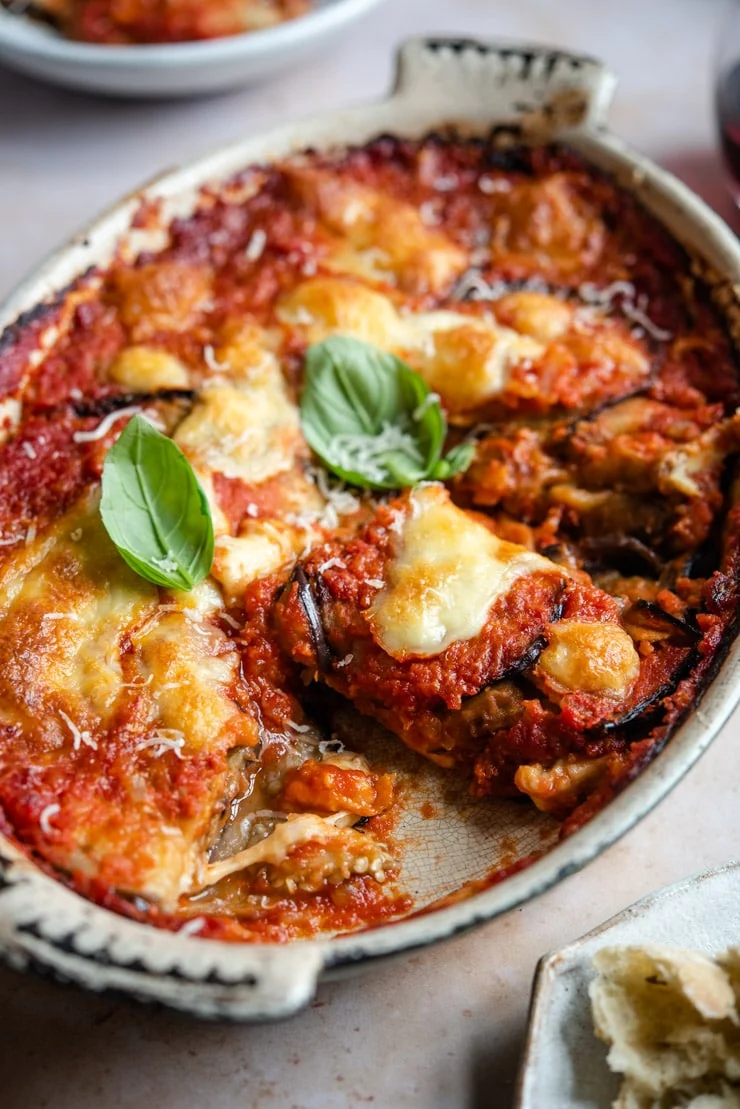Italian cuisine is loved around the world for its rich flavors and comforting dishes. From creamy pastas to savory soups, there’s something for everyone in the wide array of Italian recipes. Whether you’ve grown up enjoying these classics or are new to Italian cooking, these recipes will bring the delicious tastes of Italy right to your kitchen. Discovering these 35 classic Italian recipes will inspire you to explore and enjoy the diverse and delicious world of Italian cuisine.
1) Margherita Pizza
Margherita Pizza is a classic Italian dish known for its simplicity and delicious flavors. You start by making the dough with flour, water, yeast, and salt. Kneading the dough is crucial to get the right texture. Once the dough is ready, let it rest to rise.
Use fresh tomatoes to create a flavorful sauce. Crush them with your hands and season with a pinch of salt. Spread the sauce over the rolled-out dough, leaving a small border around the edges for the crust.
For the cheese, fresh mozzarella is best. Cut it into small cubes and drain it well to avoid a soggy pizza. Spread the mozzarella evenly over the sauce. Add fresh basil leaves for that authentic touch.
Preheat your oven to a high temperature. If you have a woodfire oven, cook the pizza at around 842°F for about 90 seconds, turning it halfway. If using a regular oven, bake at the highest setting for about 7-10 minutes until the crust is golden and the cheese is bubbly.
The classic Margherita Pizza is ready to enjoy when the crust is crispy, the cheese is melted, and the basil is fragrant. Serve it hot for the best experience.
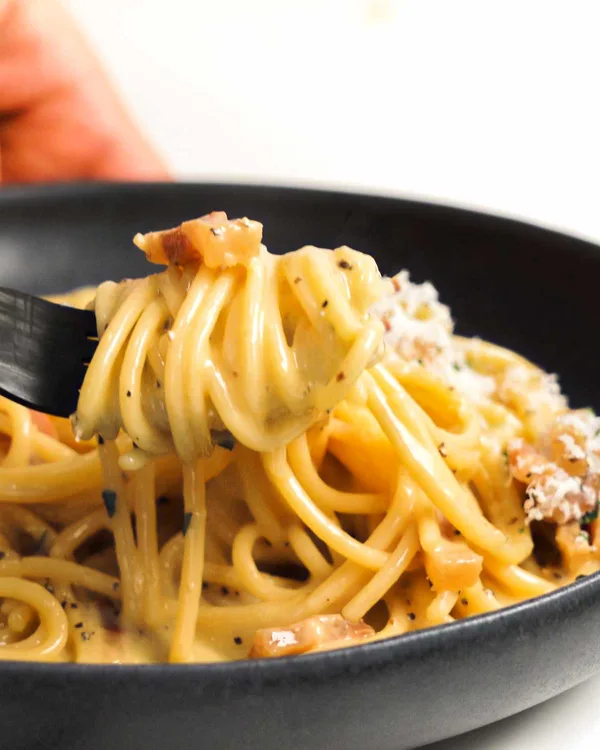
2) Spaghetti Carbonara
Spaghetti Carbonara is a classic Italian dish known for its creamy, rich flavor. The key ingredients include spaghetti, egg yolks, pecorino cheese, guanciale, and black pepper.
Start by boiling a large pot of salted water. Cook the spaghetti until it is al dente. While the pasta cooks, cut guanciale into small strips. Fry the guanciale in a hot skillet until it is crispy.
In a bowl, whisk together egg yolks, grated pecorino cheese, and black pepper. Mix until smooth. Once the pasta is cooked, drain it and return it to the pot. Make sure the pot is off the heat to avoid scrambling the eggs.
Quickly pour the egg mixture over the hot pasta, tossing it to coat evenly. The residual heat from the pasta will cook the eggs, making a creamy sauce. Finally, add the crispy guanciale and stir gently.
Serve your Spaghetti Carbonara immediately with more grated pecorino and a sprinkle of black pepper. This dish is enjoyed best when piping hot and freshly made.
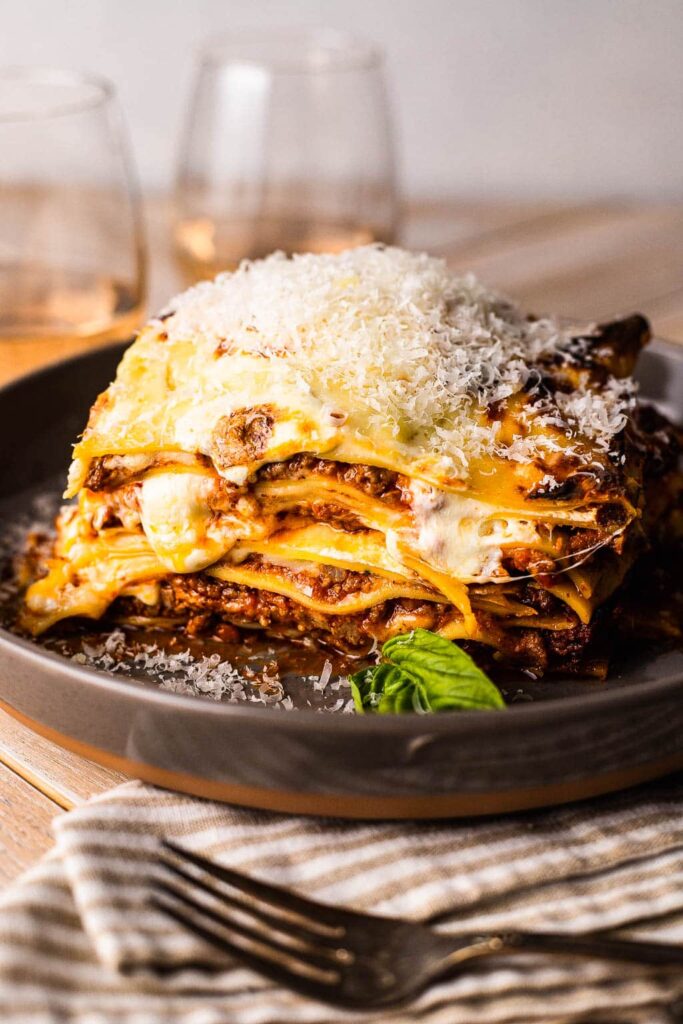
3) Lasagna Bolognese
Lasagna Bolognese is a traditional Italian comfort food. It features layers of rich meat sauce, creamy béchamel, and tender pasta. You usually make the meat sauce, known as ragù, with ground beef, pancetta, onions, celery, and carrots.
Start by sautéing finely chopped veggies until soft. Add ground beef and cook until browned. Pour in a bit of wine and let it evaporate. This adds depth to the flavor.
Next, make the béchamel sauce. Melt butter, add flour, and whisk to form a paste. Slowly add milk, whisking constantly to avoid lumps. Season with salt, pepper, and a pinch of nutmeg for extra warmth.
Now, assemble the lasagna. Spread a thin layer of meat sauce at the bottom of your baking dish. Add a layer of cooked lasagna noodles, then more meat sauce, and a drizzle of béchamel.
Repeat the layers until all the ingredients are used. Finish with a generous topping of grated Parmesan cheese for a golden, crispy crust. Bake in a preheated oven until bubbling and golden.
Lasagna Bolognese is perfect for family gatherings and special occasions. Serve it hot, and enjoy the mix of flavors and textures in every bite.
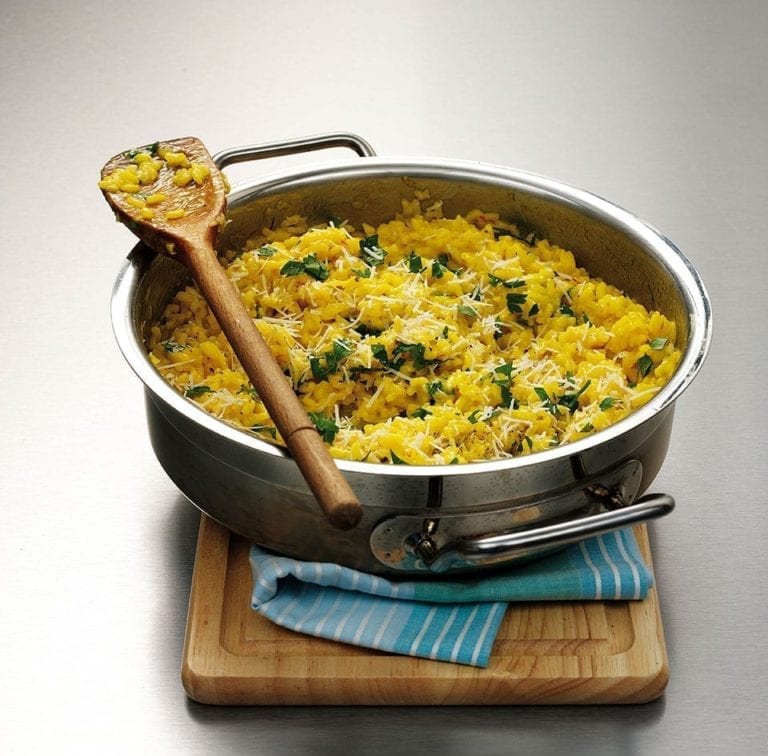
4) Risotto alla Milanese
You’ll love Risotto alla Milanese for its rich, creamy texture and vibrant saffron flavor.
Start by heating your chicken or vegetable stock in a separate pot. It’s important to keep it warm throughout the cooking process.
In a large pan, melt some butter and add bone marrow if desired. Sauté finely chopped onions until they become soft and translucent.
Next, add the Arborio rice to the pan. Stir the rice until it is well coated with the butter and onions.
Pour in white wine and let it simmer until the liquid is mostly absorbed.
Add a ladle of warm stock to the rice, stirring constantly. Once the liquid has been absorbed, add another ladle of stock. Repeat this process until the rice is tender but still has a slight bite.
Crush saffron threads into a small amount of warm stock and let it steep for a few minutes. Add this saffron-infused stock to the risotto, stirring well to combine.
Finish by stirring in a generous amount of grated Parmesan cheese and some more butter if you like. Let the risotto rest for a minute before serving.
Enjoy your Risotto alla Milanese as a flavorful main dish or a delightful side.
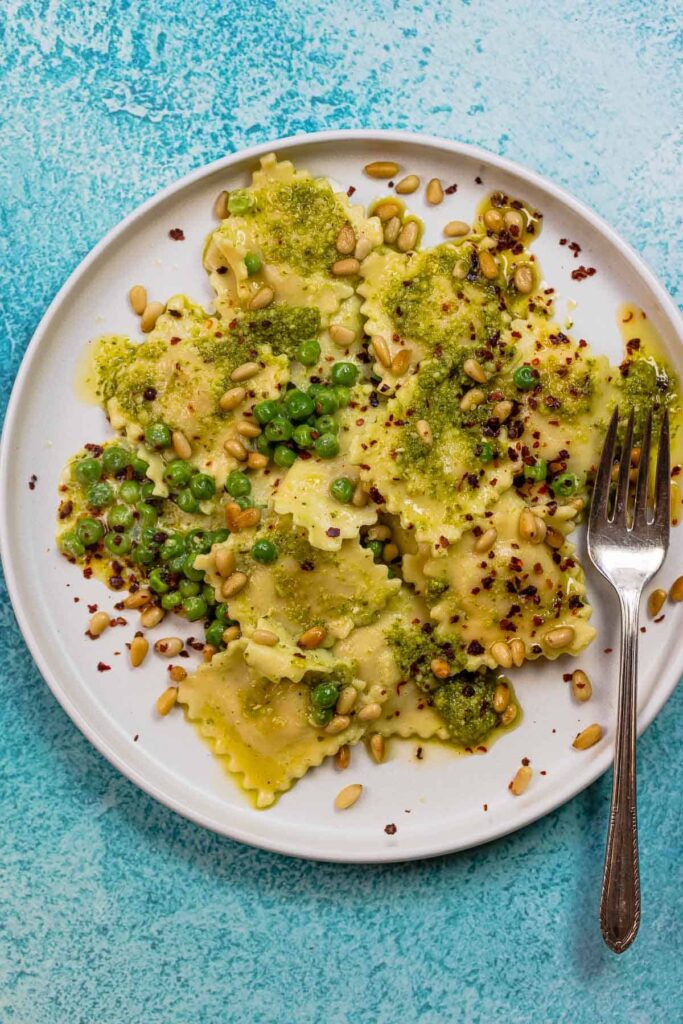
5) Ravioli al Pesto
Ravioli al Pesto is a classic Italian dish that blends the rich flavors of basil pesto with tender stuffed pasta.
Start by cooking the ravioli until al dente. Make sure to reserve a bit of the pasta cooking water.
While the pasta cooks, prepare the pesto. Combine fresh basil, garlic, pine nuts, Parmesan cheese, and olive oil in a blender. Blend until smooth but keep some texture.
In a large bowl, mix the cooked ravioli with the pesto. Add a small amount of the reserved pasta water to help the sauce stick to the pasta. You can include vegetables like peas or cherry tomatoes for extra flavor.
Drizzle a bit of extra virgin olive oil over the plated ravioli. This enhances the rich, herbal notes of the pesto.
Serve your Ravioli al Pesto with a sprinkle of Parmesan cheese and a garnish of fresh basil leaves. Enjoy this simple yet elegant Italian dish!
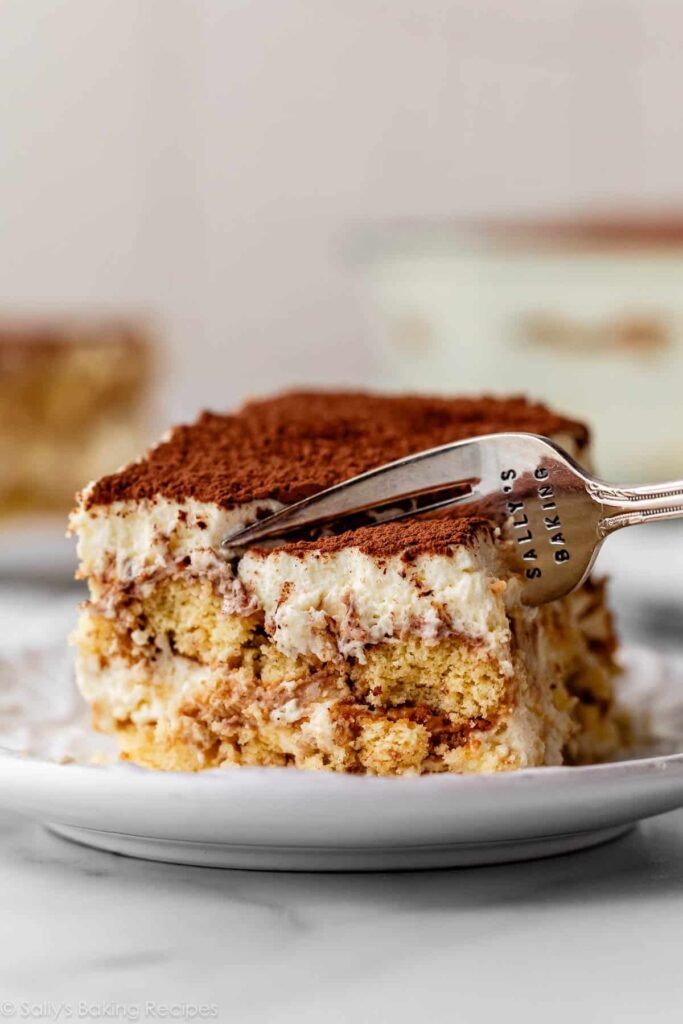
6) Tiramisu
Tiramisu is a classic Italian dessert that you can easily make at home. This creamy treat consists of layers of coffee-soaked ladyfingers and a rich mascarpone mixture. When done right, it’s both indulgent and elegant.
Start by making a strong espresso. You’ll dip ladyfingers in it, but be quick. Dip each ladyfinger for just a second or two. If they get too wet, your tiramisu will be soggy.
Next, separate your eggs. Beat the yolks with sugar until they turn pale and creamy. Add mascarpone cheese in batches, mixing until smooth.
Whip heavy cream until stiff peaks form. Gently fold it into the mascarpone mixture. This will make the dessert light and fluffy.
Layer your ladyfingers in a dish. Cover them with a layer of mascarpone mixture. Repeat the layers until you fill the dish.
Chill the tiramisu in the fridge for several hours. This allows the flavors to blend and the dessert to firm up. Just before serving, dust the top with cocoa powder. This adds a touch of bitterness that balances the sweet, creamy layers.
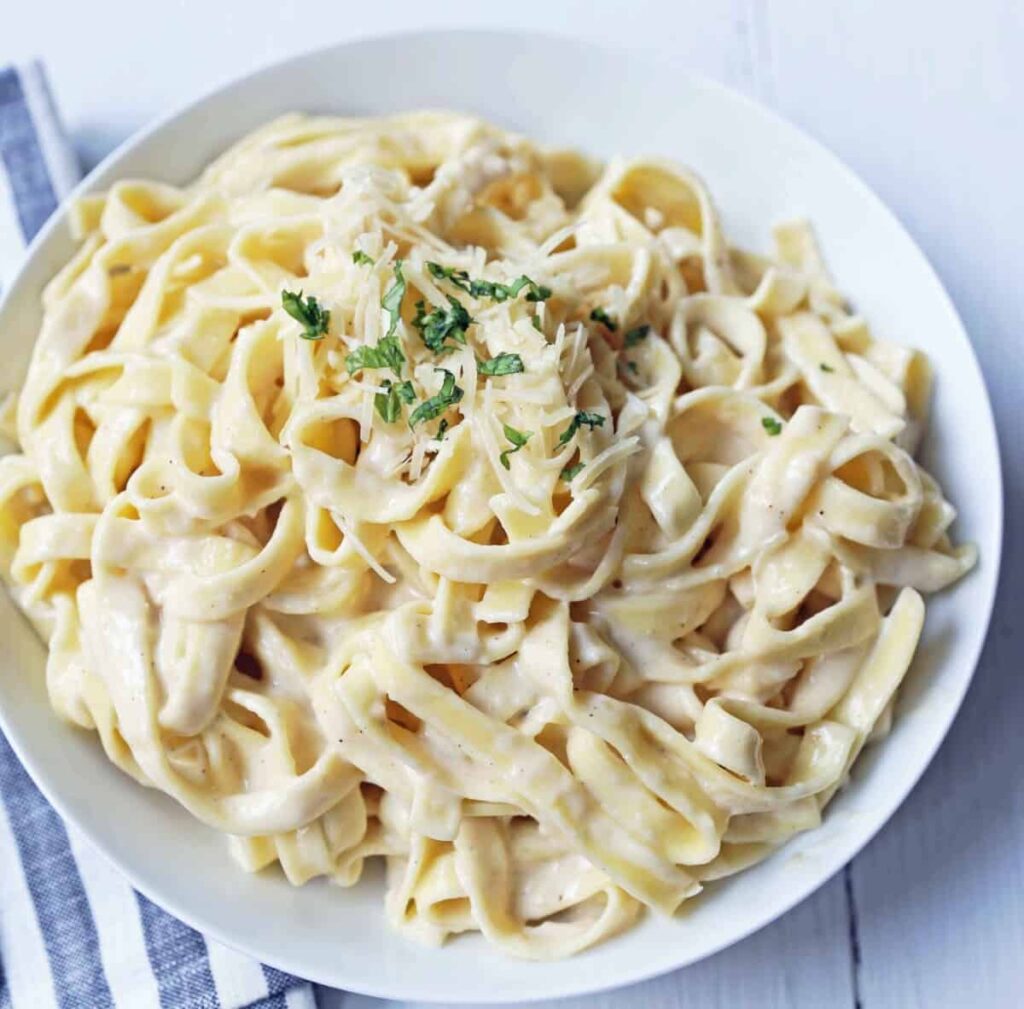
7) Fettuccine Alfredo
Fettuccine Alfredo is a delightful Italian pasta dish known for its rich and creamy sauce.
To make this dish, you start by boiling fettuccine noodles until they are al dente. You should follow the package instructions for the best results.
While the pasta cooks, melt butter in a large bowl. Once the pasta is ready, reserve some of the pasta water, as you will need it later.
Drain the pasta and immediately add it to the butter. Add a bit of the reserved pasta water to help create a smooth sauce.
Next, mix in grated Parmesan cheese. The heat from the pasta will melt the cheese, making the sauce creamy.
You can adjust the consistency of the sauce by adding more pasta water if needed. Add salt and pepper to taste.
Serve the Fettuccine Alfredo immediately, with extra Parmesan cheese on top for garnish. This dish is best enjoyed fresh and hot.
With few ingredients and simple steps, Fettuccine Alfredo is a classic that brings the flavors of Italy right to your table.
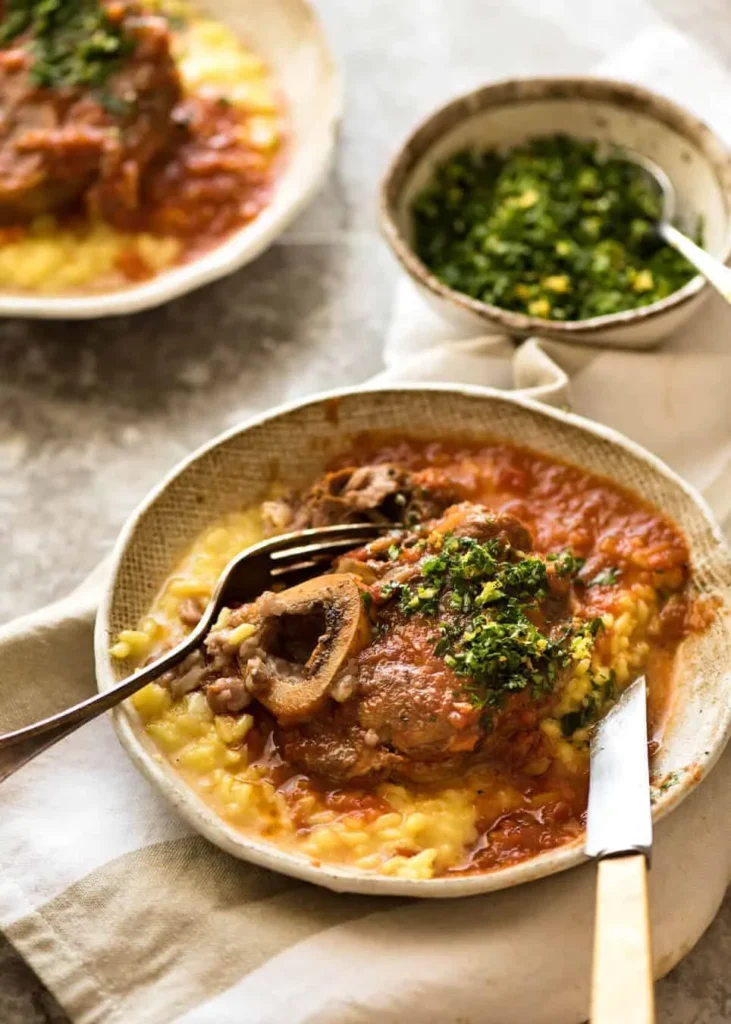
8) Osso Buco
Osso Buco is a classic Italian dish from Milan. It features veal shanks braised with vegetables, white wine, and broth. The name means “bone with a hole,” which refers to the marrow-filled bone in the center of the veal shank.
To prepare Osso Buco, you start by seasoning the veal shanks with salt and pepper. Then, dredge them lightly in flour. In a large pan, heat a mix of butter and oil. Brown the shanks on all sides.
Next, remove the shanks and sauté finely chopped onions in the same pan until they become transparent. Add in the veal shanks again, followed by wine. Let the wine reduce by half.
Add broth, tomato paste, and seasonings like bay leaves and sage. Bring to a boil, then reduce to a simmer. Cover the pan and cook for about 1.5 to 2 hours, or until the meat is tender enough to break with a fork.
Osso Buco is traditionally served with gremolata, a mix of lemon zest, garlic, and parsley. This adds a fresh and zesty flavor to the rich, savory dish. Pair it with risotto or polenta for a complete meal.
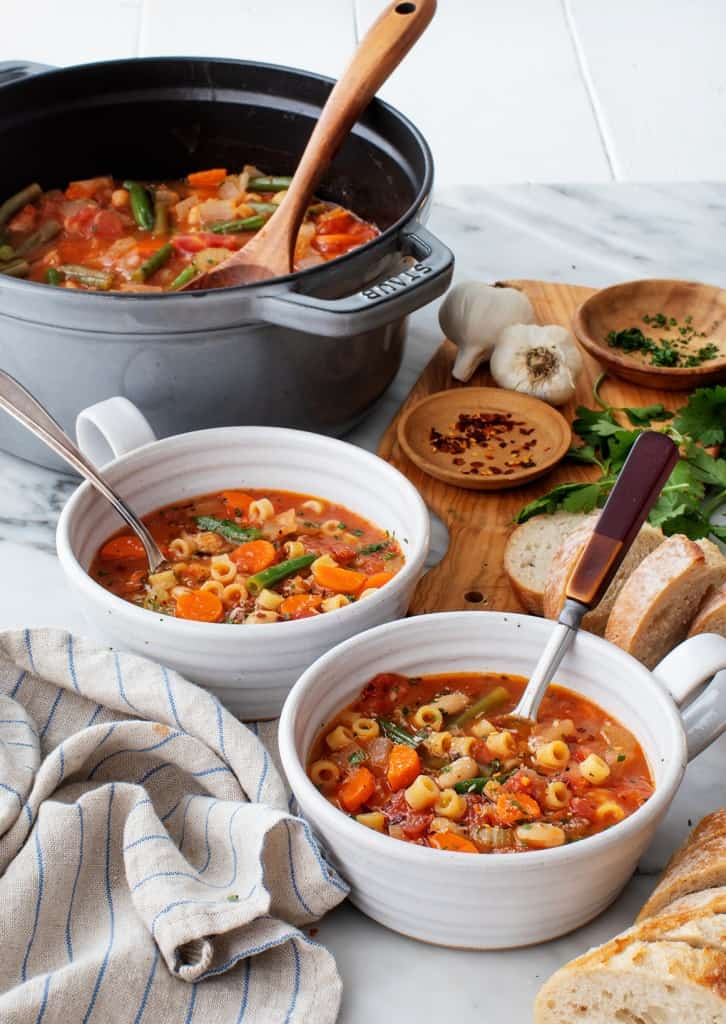
9) Minestrone Soup
Minestrone soup is a hearty Italian vegetable soup that varies by season and region. You can customize it with your favorite vegetables.
Start by sautéing onions, garlic, carrots, and celery in olive oil.
Add diced potatoes, butternut squash, tomatoes, and bay leaf. Pour in water or broth until the vegetables are just covered.
Let the soup simmer on low heat for about 40 minutes.
At this point, you can add zucchini, green beans, or other green vegetables. Season with rosemary, paprika, and salt.
For extra flavor, add a Parmesan rind while the soup cooks.
Some recipes call for pasta or beans, which you can add during the last 10 minutes of cooking.
Serve the soup hot, optionally topped with fresh herbs or grated Parmesan cheese.
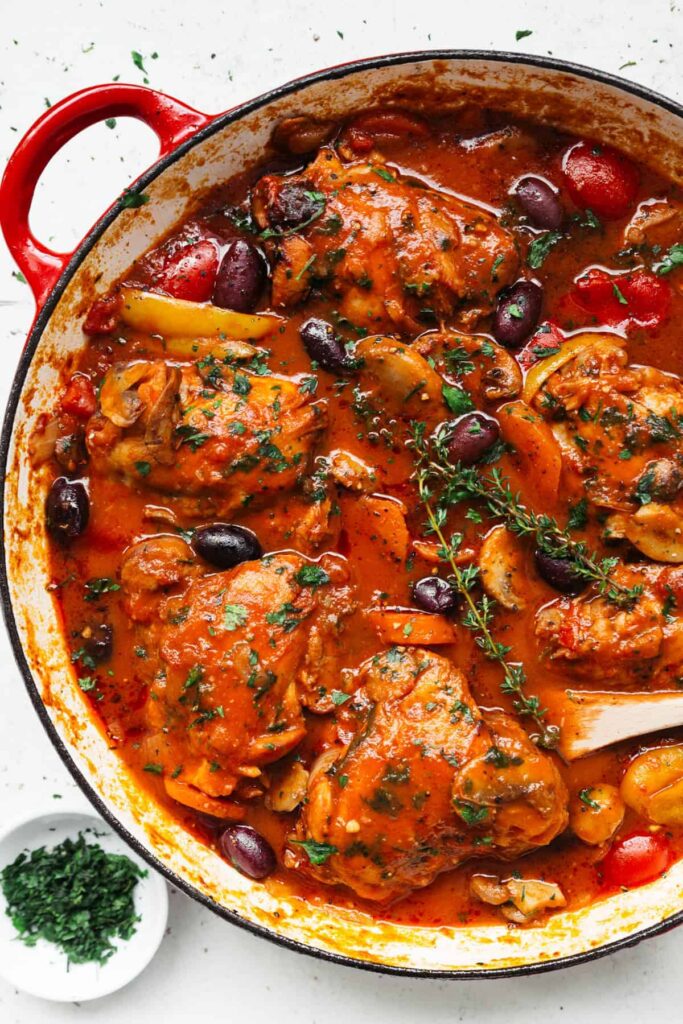
10) Chicken Cacciatore
Chicken Cacciatore is a traditional Italian stew known for its rich flavors. “Cacciatore” means hunter, and this dish is inspired by hunters who would cook their fresh game with herbs, vegetables, and wine.
To start, you need chicken pieces. Bone-in thighs or legs are great choices. This helps keep the meat tender and juicy during cooking.
First, season the chicken with salt and pepper. You then sear the chicken in a large pot or skillet until golden brown. This step locks in the flavor.
Next, add your chopped onions, garlic, carrots, and celery to the pot. Cook these vegetables until they begin to soften. This forms the base of your stew.
After that, pour in some red wine. Let it simmer to reduce slightly. This adds a deep, rich flavor to the dish.
Then, mix in crushed tomatoes, thyme, bay leaves, and bell peppers. Stir well and let everything come to a gentle simmer. Cover the pot with a tight lid.
Cook for about 50 minutes in an oven set to 375°F (190°C). This allows the flavors to meld and the chicken to become tender.
Toward the end, you can add olives if you like. They add a salty depth to the dish. Serve your Chicken Cacciatore hot, garnished with fresh herbs. Enjoy!
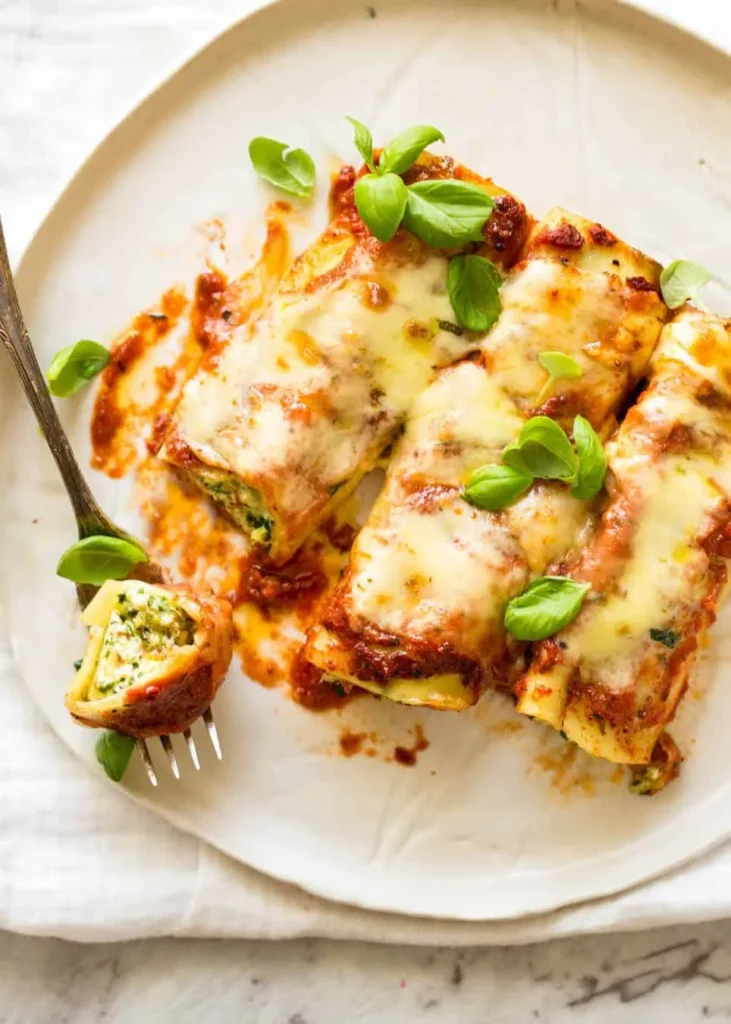
11) Cannelloni
Cannelloni is a classic Italian dish made with pasta tubes filled with a rich mixture and baked to perfection.
To prepare the pasta, you combine flour and eggs, mixing until the dough reaches the right consistency. If the dough is too soft, add more flour. If it is too dry, add a little water.
For the filling, ground meat is often used. Brown the meat in olive oil, then remove it from the pan. In the same pan, cook onion, garlic, and celery until soft. Combine these with the browned meat.
Boil the pasta tubes briefly and cool them in an ice bath. Spread the filling inside each tube. Place the filled tubes in a baking dish.
Top the cannelloni with tomato sauce or besciamella. Bake it in a preheated oven until the sauce is bubbly and the pasta is tender.
Enjoy this delicious Italian comfort food with a side of fresh vegetables or a crisp salad. Cannelloni can be customized with different fillings, such as cheese, spinach, or various meats.
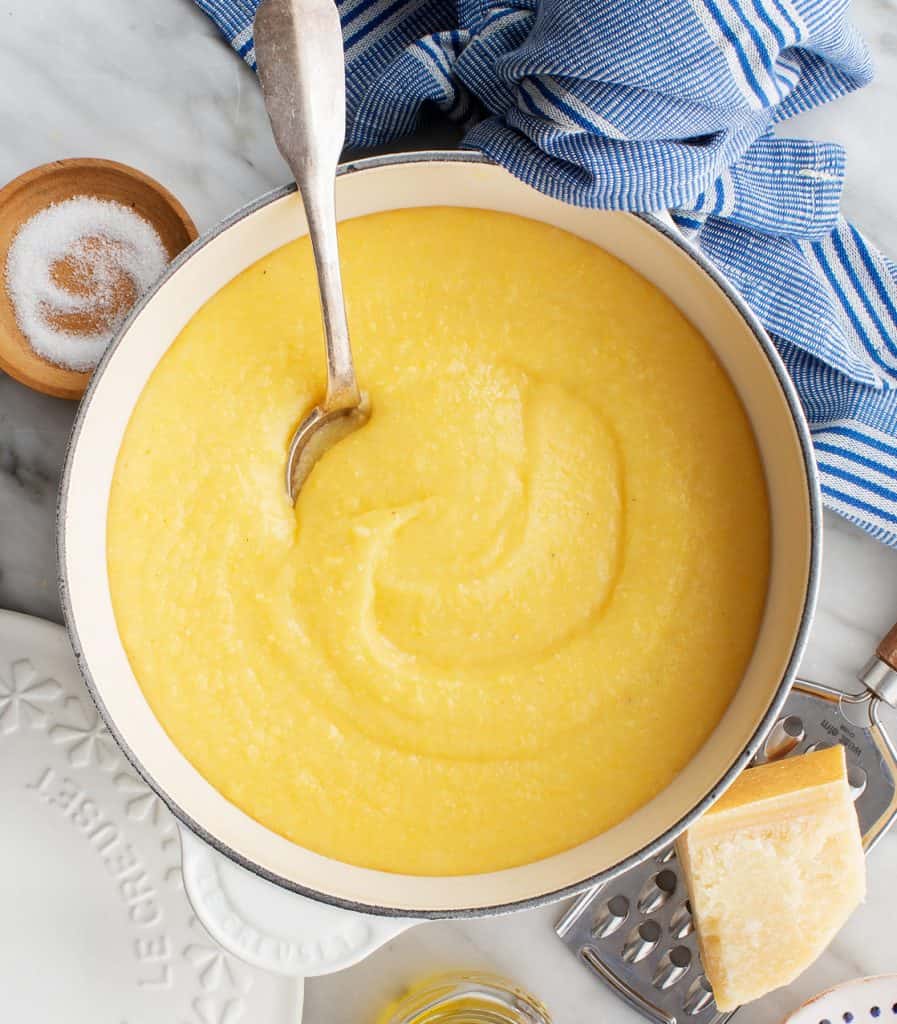
12) Polenta
Polenta is a classic Italian dish made from cornmeal. It can be served creamy, firm, or even grilled.
To start, you’ll need 4 to 6 cups of water and a thick-bottomed pot. Bring the water to a strong boil. Gradually add the cornmeal in a steady stream, whisking continuously.
Once you’ve added all the cornmeal, reduce the heat to a simmer. Keep whisking until the mixture is thick and smooth. This usually takes about 45 minutes. It’s important to keep stirring to prevent lumps.
For a creamier texture, some recipes suggest adding butter and cheese like Fontina. Cut the cheese into small cubes and add it to the polenta while it’s still hot.
Another method is cooking polenta in the microwave. Boil salted water in a microwave-safe container for 2 minutes. Gradually add the cornmeal, mixing well. Cook for 20 minutes, stirring every 5 minutes. Check for consistency and add more water if needed.
Once the polenta is ready, you can serve it immediately or let it cool and set. Once firm, it can be sliced and grilled or fried for a crispy texture. Polenta is versatile and pairs well with various sauces and meats.
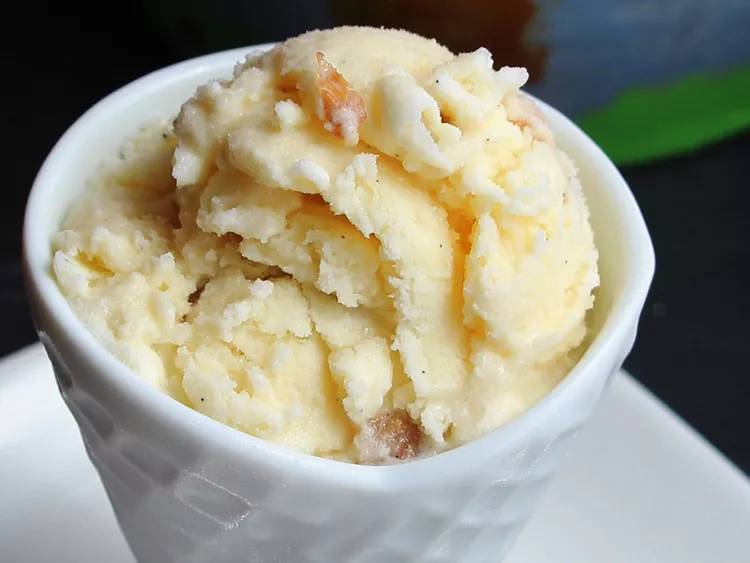
13) Gelato
Gelato is a traditional Italian frozen dessert that is creamy and rich. It differs from ice cream by having less fat and a denser texture. Unlike ice cream, gelato is churned at a slower speed, which incorporates less air and makes it smoother.
To make gelato at home, start with fresh, high-quality ingredients. Use whole milk and heavy cream for the base. Sweeten with granulated sugar and add egg yolks for richness. Flavorings like vanilla, coffee, or fruit can be added to customize your gelato.
If you don’t have an ice cream maker, you can still make gelato. Pour the mixture into a gelato container, freeze it, and stir every 30 minutes to break up ice crystals. Repeat until it reaches a creamy consistency, usually after around 5 hours.
For a classic Fior di Latte gelato, use sugar and fresh whole milk. It’s simple yet delicious. A coffee gelato, made with ristretto coffee, sugar, and cream, offers a richer taste.
Remember to thaw your gelato in the fridge for 10 to 15 minutes before serving. This helps soften it and makes it easier to scoop. Enjoy it quickly, as gelato is best when fresh.

14) Bruschetta
Bruschetta is a classic Italian appetizer known for its simplicity and flavor. You start by slicing a baguette into 1/4 to 1/2 inch slices and toasting them. Rub each piece with a garlic clove to infuse a hint of garlic taste.
Next, drizzle olive oil on both sides of the toasted bread. You can use a brush to ensure even coverage.
Prepare the tomato topping by cutting tomatoes into small dices and adding chopped basil leaves. Mixing these ingredients together releases their fresh aromas.
Spoon the tomato mixture onto the toasted bread slices. Make sure each piece is well covered.
Add a sprinkle of salt and, if you like, a drizzle of balsamic vinegar for extra flavor. Enjoy your homemade bruschetta as a tasty starter or snack.
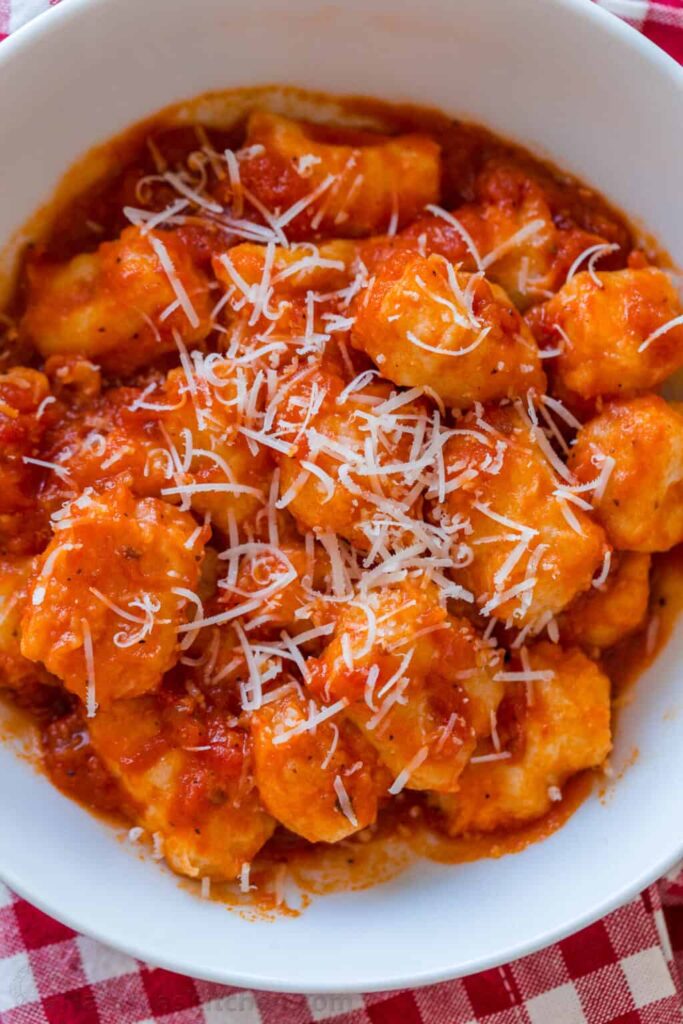
15) Gnocchi
Gnocchi are small, soft dumplings made from potatoes, flour, and eggs. They are a staple in Italian cuisine. The texture is like fluffy pillows, which makes them a favorite comfort food.
To make gnocchi, start by baking or boiling potatoes. Once tender, mash them until smooth. Add flour and a beaten egg to form a dough.
Roll the dough into ropes about 3/4-inch in diameter. Cut the ropes into small pieces, each about 2 centimeters long. Roll each piece over a fork or gnocchi board to create ridges.
Cook the gnocchi in boiling water. They are ready when they float to the surface, which takes about 3-5 minutes. Toss them in your favorite pasta sauce and let them cook for another 2-3 minutes.
For a traditional touch, serve gnocchi with a simple tomato sauce or a rich, creamy sauce. You can also freeze uncooked gnocchi to use later. This makes them a convenient option for quick meals.
Gnocchi are versatile and can pair with many sauces, from pesto to brown butter and sage. This adaptability makes them a beloved dish in Italian households.
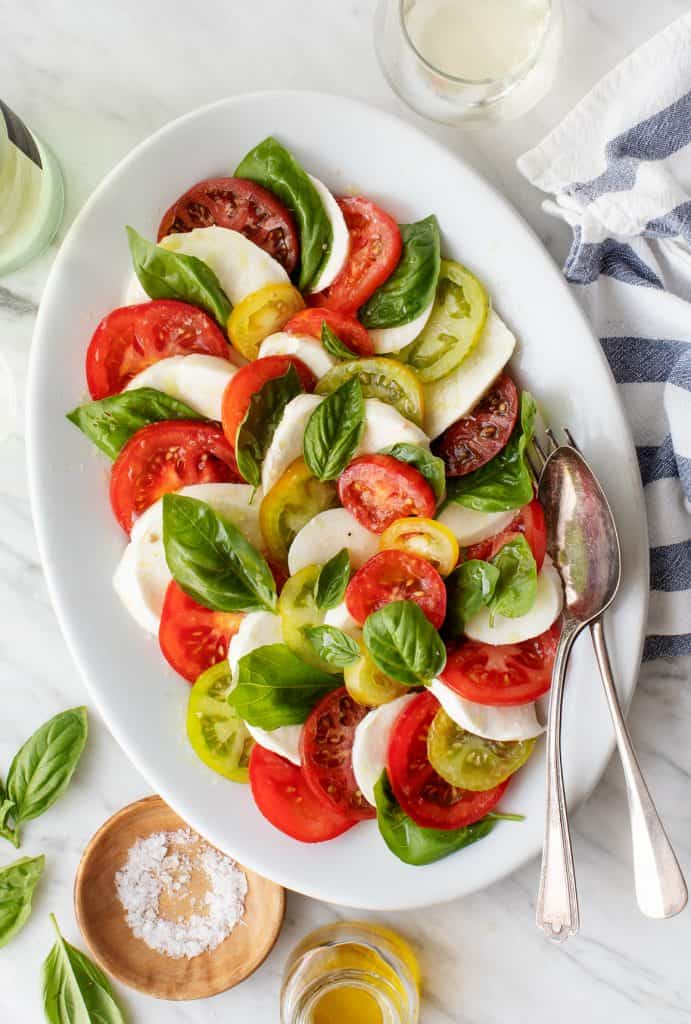
16) Caprese Salad
Caprese Salad is a classic Italian dish that’s simple yet delicious. You only need a few ingredients.
First, gather ripe tomatoes, fresh mozzarella, and basil leaves. Make sure your tomatoes are juicy and the mozzarella is soft.
Start by slicing the tomatoes into ¼-inch to ½-inch slices. Lay them out on a serving platter.
Next, slice the mozzarella to a similar thickness. Arrange the cheese slices between the tomato slices.
Tuck fresh basil leaves between the layers. They add a wonderful aroma and flavor to the salad.
Drizzle everything with extra virgin olive oil. This adds richness and enhances the flavors.
Add a sprinkle of salt and pepper. If you like, you can also drizzle some balsamic vinegar for a bit of tanginess.
Let the salad sit for about 5 to 10 minutes before serving. This helps the flavors meld together.
Enjoy this refreshing and easy-to-make salad any time of year!
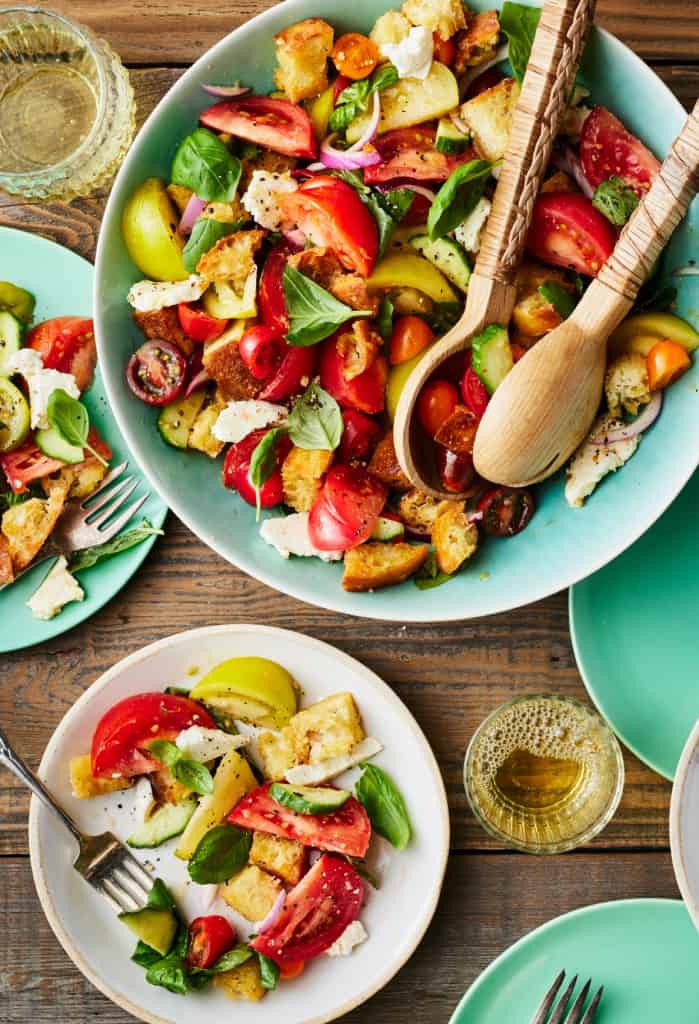
17) Panzanella
Panzanella is a traditional Italian salad made with stale bread and ripe tomatoes. It’s popular in Tuscany, especially during the summer months. This dish makes use of simple ingredients that highlight the flavors of fresh produce.
To start, cut the bread into coarse pieces. You can use stale or toasted bread. Combine water and vinegar, then sprinkle onto the bread, allowing it to soak for about 20 minutes. The bread should be lightly moistened, not soaked.
Slice ripe tomatoes and toss them with the bread. Adding diced bell peppers, thinly sliced shallots, and fresh basil will give the salad extra flavor. Some variations include mozzarella or olives for added richness.
The dressing is just as important. Mix together olive oil, red wine vinegar, garlic, Dijon mustard, and a pinch of black pepper. Drizzle it over the salad and toss well. Let the salad sit for about 20-30 minutes to let the flavors meld together before serving.
Panzanella is best enjoyed fresh. It’s a great way to use up leftover bread and enjoy the taste of summer. This salad pairs well with grilled meats or can be enjoyed on its own as a light meal.
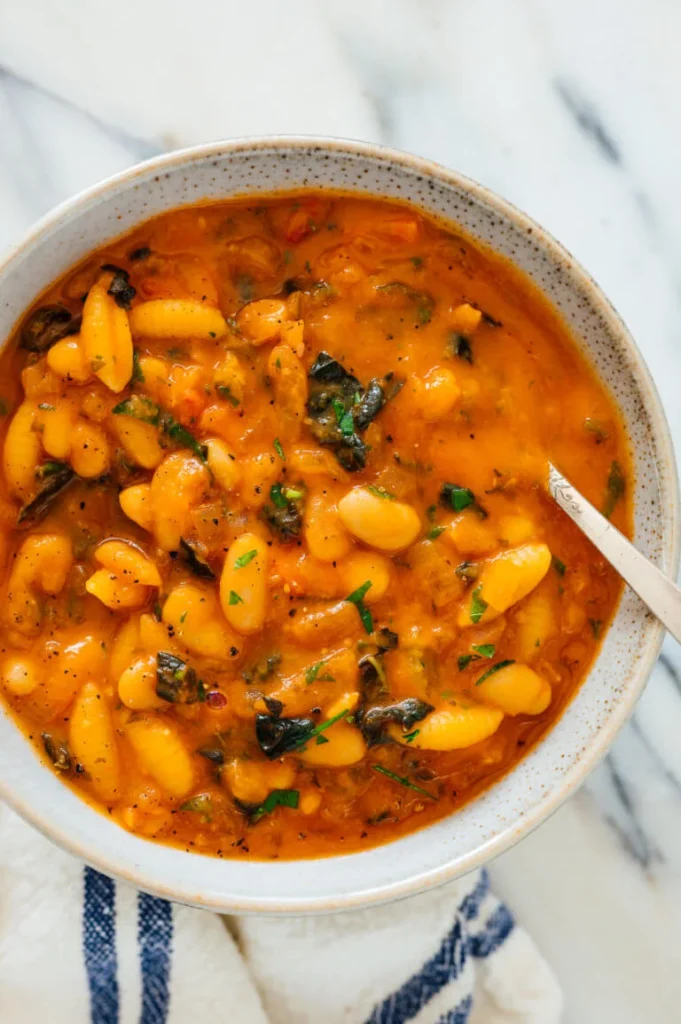
18) Pasta e Fagioli
Pasta e Fagioli is a comforting classic Italian dish. It is a hearty soup made with pasta and beans. This dish is perfect for a cozy family dinner or a gathering with friends.
You start by soaking beans in water overnight. This helps soften them for cooking. After soaking, drain and rinse the beans. Place them in a large pot with fresh water and bay leaves. Cook the beans over low heat for a few hours until they are tender.
In another pot, heat olive oil. Add chopped onions, garlic, and sometimes pancetta or bacon. Sauté until the onions are golden and fragrant.
Blend half of the cooked beans until smooth. This adds a creamy texture to the soup. Add the blended beans, whole beans, and stock to the pot with sautéed ingredients. Bring the mixture to a boil.
Then, add pasta to the boiling soup. Let it simmer until the pasta is al dente. You can add more olive oil, salt, and pepper for extra flavor. Serve hot with a sprinkle of Parmesan cheese and fresh parsley.
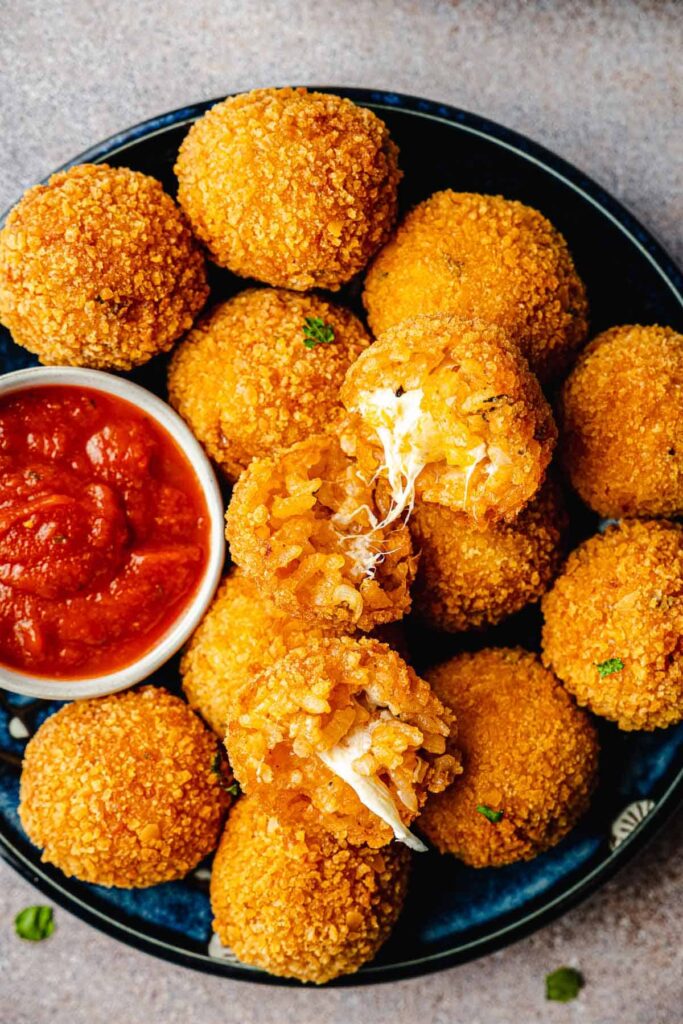
19) Arancini
Arancini are delicious Italian rice balls that are crispy on the outside and soft on the inside. These treats are made with risotto, stuffed with various fillings, then breaded and fried to golden perfection.
To prepare arancini, you start by cooking risotto with chicken or vegetable stock. Once the risotto is cooked and cooled, mix in grated cheese and eggs. This helps bind the rice together.
Form the risotto into balls and fill them with mozzarella, meat sauce, or peas. Roll the balls in breadcrumbs to get a crispy coating.
For a healthier version, you can use an air fryer. Preheat the air fryer to 375°F and drizzle the breaded rice balls with olive oil. Cook for 12-15 minutes until they’re golden brown, turning them occasionally.
Arancini can be served hot as an appetizer or a snack. They are a favorite at parties and make a great addition to any Italian meal.
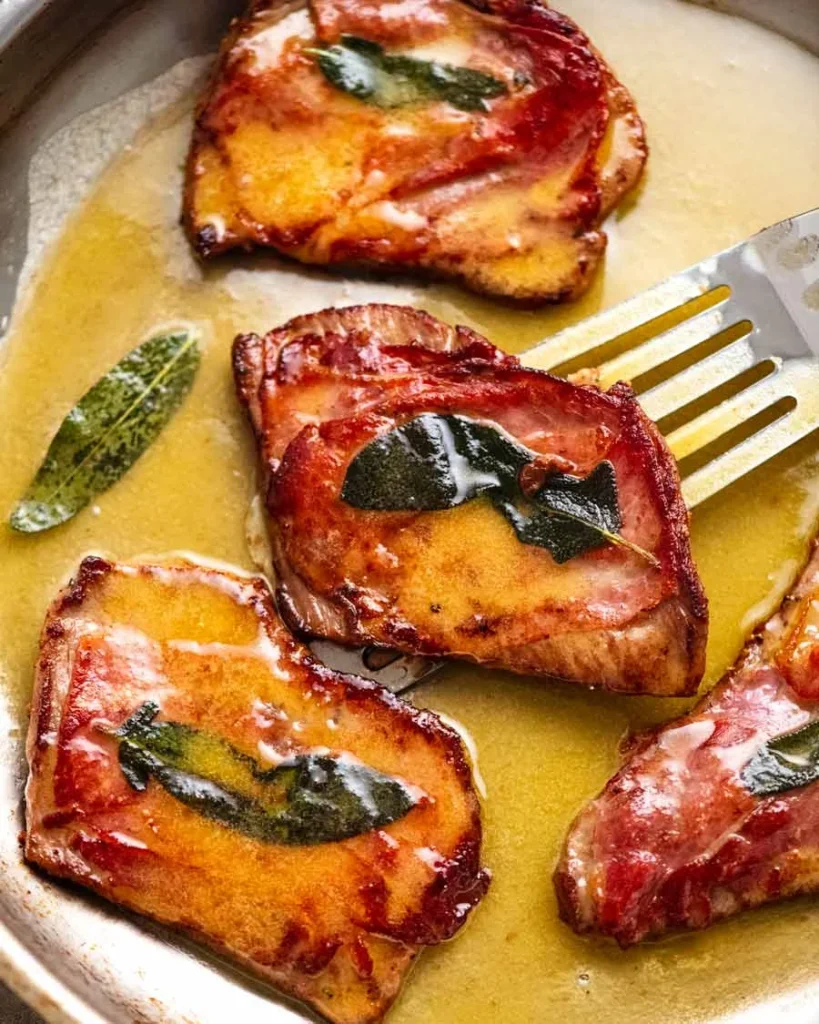
20) Saltimbocca
Saltimbocca is a classic Italian dish that means “jumps in the mouth.” This tasty recipe often features veal, but you can also use chicken or pork. You top the meat with prosciutto and sage, then secure it with toothpicks for cooking.
To start, lightly pound the meat to make it tender. Place a slice of prosciutto and a couple of sage leaves on each piece. Make sure to use toothpicks to keep everything in place.
Next, melt butter in a large skillet over high heat. Cook the meat, starting with the prosciutto side down, for about 2 minutes. Turn the meat over to cook the other side until it’s just done, usually about a minute.
After the meat is cooked, you can make a simple sauce. Pour white wine into the skillet and let it simmer for a couple of minutes. This will help lift the tasty bits stuck to the pan and add flavor to your sauce.
Serve your Saltimbocca hot, pouring the sauce over the meat. This elegant dish pairs well with roasted vegetables or a simple green salad.
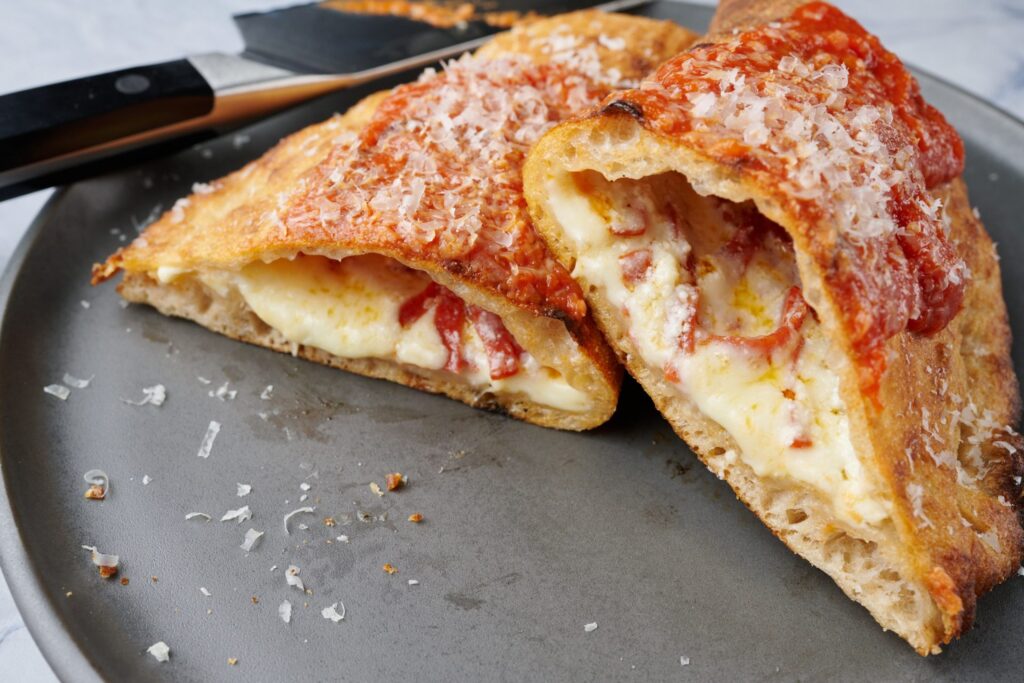
21) Calzone
Calzones are a delicious Italian dish that you can easily make at home. Think of them as folded pizzas. They are often stuffed with a mix of cheese, meats, and vegetables.
To start, you need a good pizza dough. You can make this yourself or buy it premade. The key is to make sure it’s stretchy and workable.
For the filling, combine Italian cheeses like mozzarella and ricotta. Add your favorite toppings—pepperoni, sausage, and veggies work well. Don’t overfill the calzone, or it will be hard to seal.
Roll out the dough into circles, about 8-9 inches across. Place the filling on one half of the circle. Fold the other half over and seal the edges by pinching or using a fork.
Bake in a preheated oven at around 400-450°F (200-230°C) until the crust is golden brown. This usually takes about 15-20 minutes.
Serve your calzones hot with a side of marinara sauce for dipping. They are perfect for a quick dinner or a fun meal with friends. Enjoy the combination of a crispy crust and a cheesy, warm center every time you bite into one.
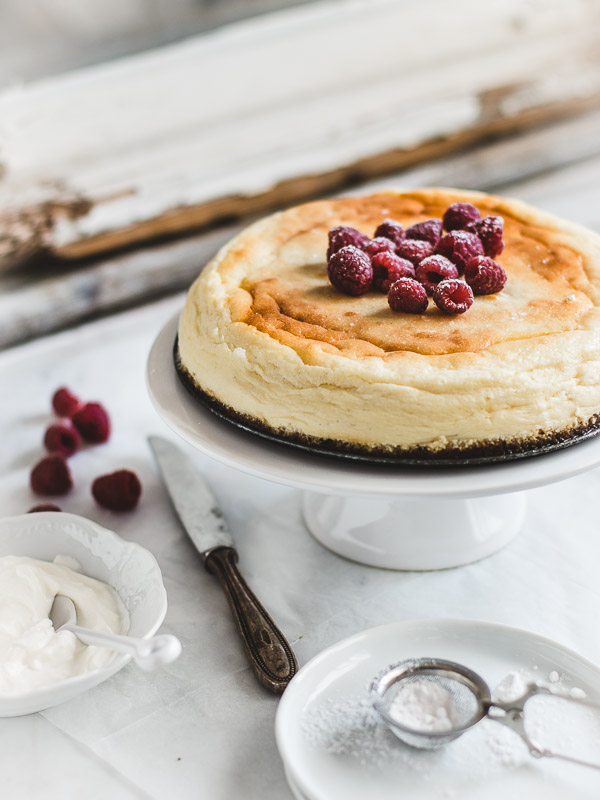
22) Ricotta Cheesecake
Ricotta cheesecake is a delightful Italian dessert known for its light and creamy texture. Unlike traditional cheesecake made with cream cheese, this version uses ricotta, giving it a unique and slightly grainy texture.
To start, you’ll need ricotta cheese, eggs, sugar, and vanilla extract. Some recipes also include ingredients like lemon zest, mascarpone, or sour cream for extra richness.
Begin by preheating your oven to 350°F. In a large bowl, mix the ricotta until it is smooth. Add the eggs, sugar, and vanilla, and blend until the mixture is creamy.
Pour the mixture into a greased springform pan lined with parchment paper. Bake for about 1 hour until the top is golden and the center is just set.
Allow the cheesecake to cool completely before removing it from the pan. This can take a few hours, so be patient. For best results, refrigerate the cheesecake overnight.
Serve your ricotta cheesecake chilled, perhaps with a dusting of powdered sugar or a drizzle of honey. This dessert pairs wonderfully with fresh berries or a citrus compote. It’s a perfect way to end a meal with a touch of Italian elegance.
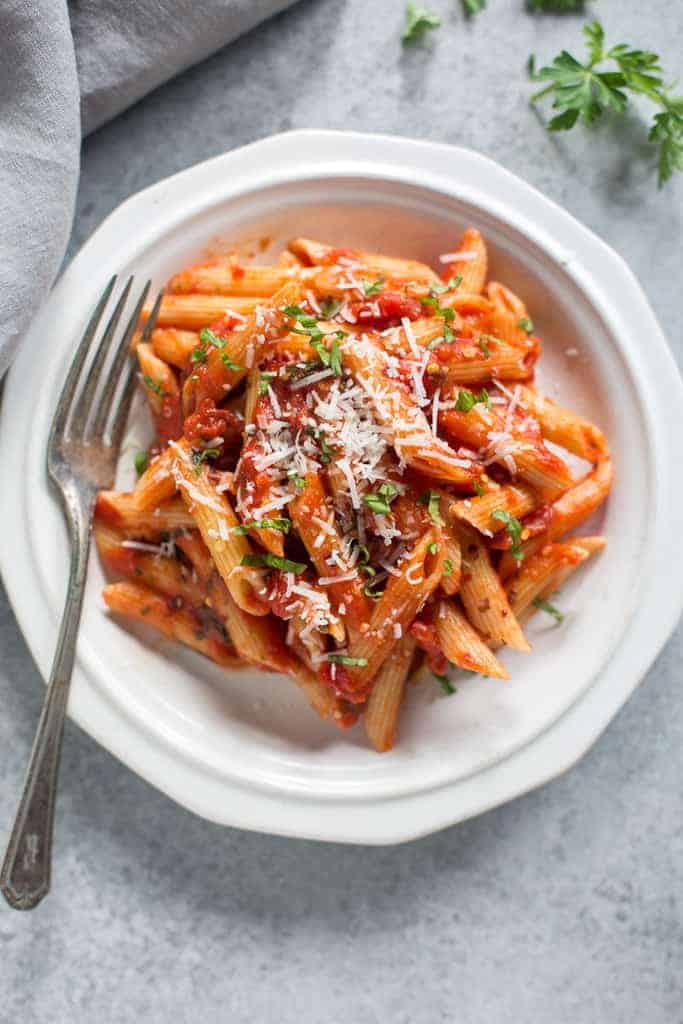
23) Penne Arrabbiata
Penne Arrabbiata is a classic Italian pasta dish known for its spicy tomato sauce. The name “arrabbiata” means “angry” in Italian, referring to the heat from the red chili peppers used in the sauce.
To start, cook penne pasta in boiling salted water until al dente. While the pasta cooks, you can prepare the sauce.
In a skillet, heat some olive oil over medium heat. Add finely chopped garlic and crushed red pepper flakes to the hot oil. Sauté for a minute until the garlic is golden and fragrant.
Next, add crushed tomatoes to the skillet. If using fresh tomatoes, boil them briefly, peel, and mash. Let the tomato mixture simmer for about 10-15 minutes, allowing the flavors to meld.
Once the pasta is cooked, drain it and add it directly to the skillet with the arrabbiata sauce. Toss the pasta to ensure it’s evenly coated with the sauce.
You can garnish the dish with fresh basil leaves for a touch of color and extra flavor. Serve the Penne Arrabbiata hot, and enjoy its bold, spicy taste.
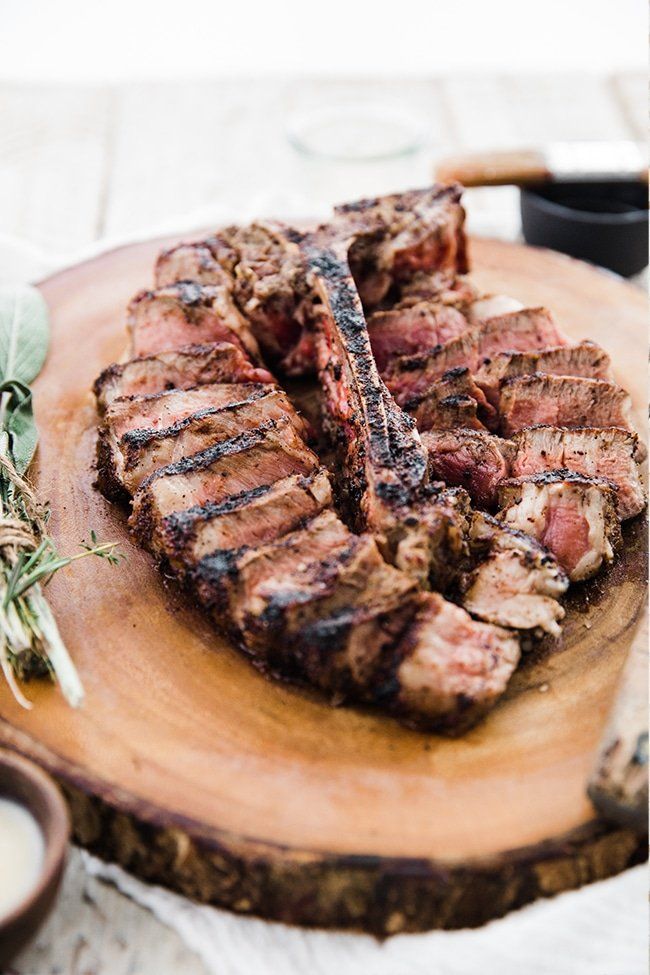
24) Bistecca alla Fiorentina
Bistecca alla Fiorentina is a famous Tuscan steak known for its simplicity and rich flavor. The key to this dish is using a high-quality T-bone or porterhouse steak, usually from a Chianina cow.
Start by removing the steak from the refrigerator about an hour before cooking. This helps it reach room temperature, ensuring even cooking.
Preheat your grill to a high or medium-high heat. Brush the steak with olive oil and season both sides generously with salt and pepper. Some recipes recommend using an herb brush made of tied rosemary and sage to spread the olive oil.
When the grill is hot, place the steak on it. For a rare steak, cook for about 4-6 minutes per side. If you prefer medium-rare, cook for an additional 2 minutes on each side. The steak should have a nice char on the outside.
Turn the steak only once during cooking. Some chefs suggest turning the steak every 30-60 seconds to keep the temperature even.
Once cooked, let the steak rest for about 5-10 minutes, covered with aluminum foil. This allows the juices to redistribute, making the meat more flavorful. Enjoy your Bistecca alla Fiorentina with a squeeze of lemon and a drizzle of olive oil if desired.
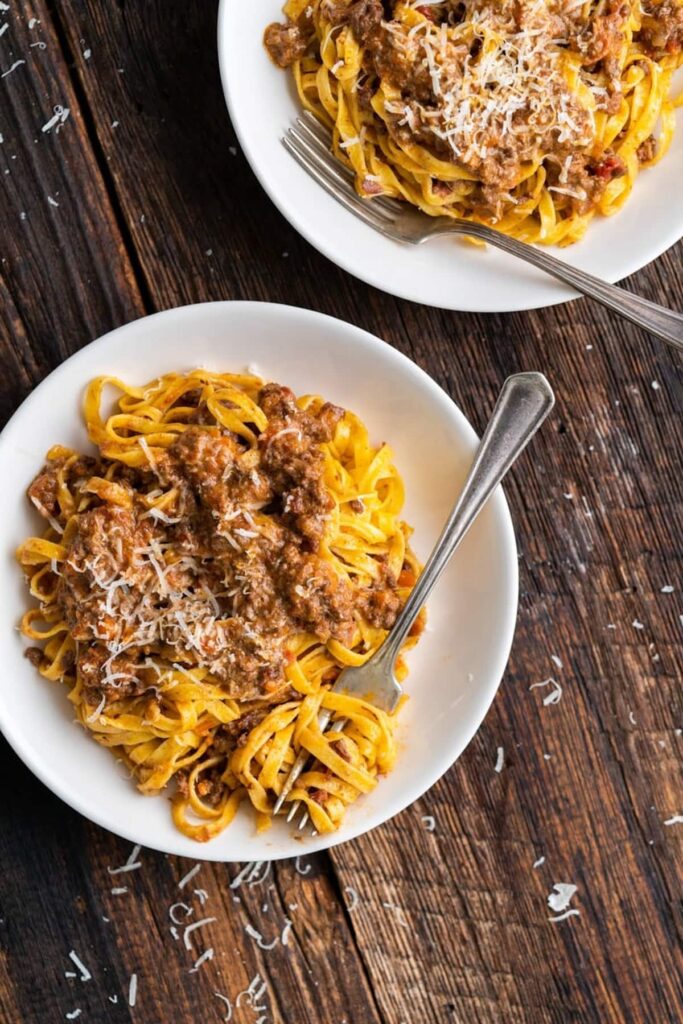
25) Tagliatelle al Ragu
Tagliatelle al Ragù is a traditional Italian dish from Bologna. It combines wide, flat pasta with a rich meat sauce.
Start by chopping pancetta, celery, carrots, and onions into fine pieces. Heat olive oil in a pan, then sauté the pancetta and vegetables until soft.
Next, add ground beef and pork. Cook until browned, about 10 minutes, stirring frequently to break up the meat.
Pour in half a cup of wine and let it evaporate completely. Add crushed tomatoes, cover, and let the sauce simmer on low heat for 2 hours.
Stir occasionally, adding a little broth if the sauce gets too dry. Toward the end, add some milk to balance the tomato’s acidity.
Serve the ragù over freshly cooked tagliatelle, and enjoy.
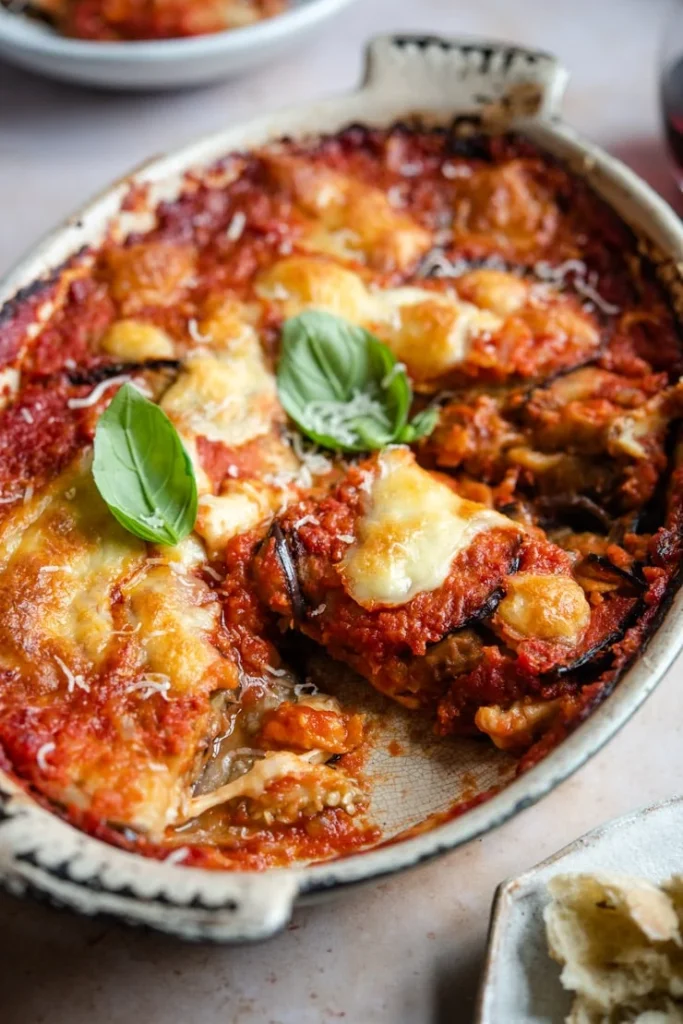
26) Parmigiana di Melanzane
Parmigiana di Melanzane, also known as Eggplant Parmesan, is a beloved Italian dish. It features layers of fried eggplant, rich tomato sauce, and delicious cheeses like mozzarella and Parmesan.
You start by slicing eggplants and lightly frying them. Dredging the slices in flour before frying gives them a nice crispy texture.
Next, you create a simple tomato sauce with fresh tomatoes, garlic, and basil. This adds a rich and tangy flavor to the dish.
In a baking dish, you layer the fried eggplant slices, tomato sauce, and a mix of mozzarella and Parmesan cheese. Repeat the layers until you fill the dish.
Bake it in the oven until the cheese is melted and bubbly. The result is a warm, comforting dish with a perfect blend of textures and flavors.
Parmigiana di Melanzane is a true classic that captures the essence of Italian cuisine. Its simplicity and heartiness make it a favorite for many.
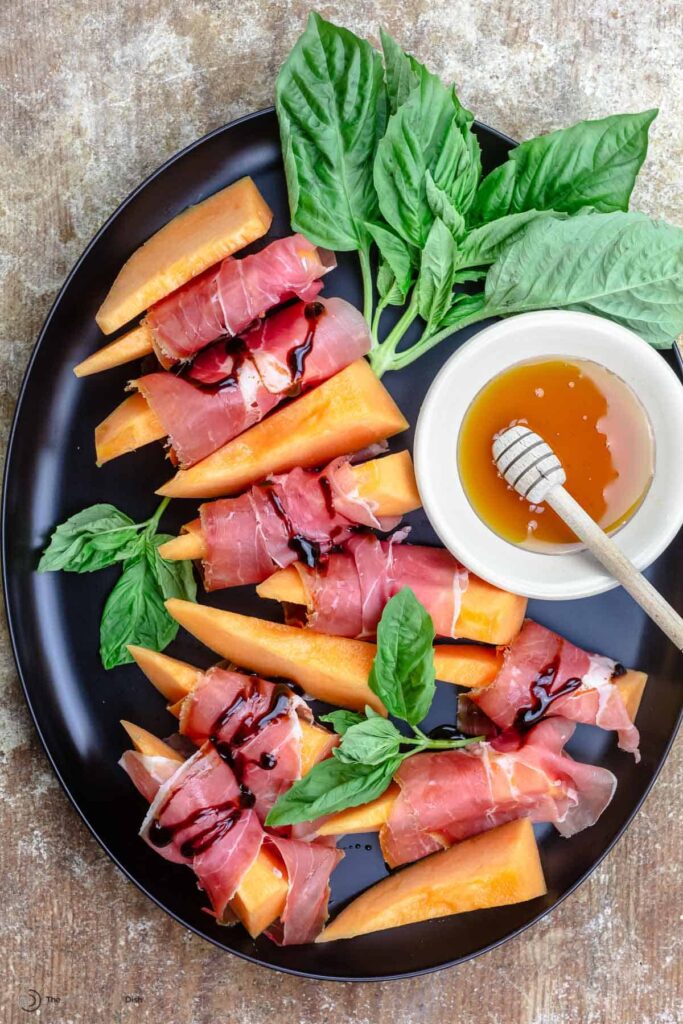
27) Prosciutto e Melone
Prosciutto e Melone is a classic Italian dish that combines sweet and salty flavors. This simple recipe uses just two main ingredients: ripe cantaloupe and prosciutto ham.
To start, select a ripe cantaloupe. Cut the melon in half, remove the seeds, and slice it into wedges. You can remove the rind for easier eating or leave it on for presentation.
Next, take thin slices of prosciutto and wrap them around each melon wedge. Ensure the prosciutto covers most of the melon but leaves a bit showing at the ends for a nice look.
Some variations may include drizzling a few drops of balsamic vinegar over the top before serving. This adds an extra layer of flavor.
Prosciutto e Melone is perfect as an appetizer or a light snack. It’s refreshing and easy to make, requiring no cooking at all. Serve it chilled for the best experience.
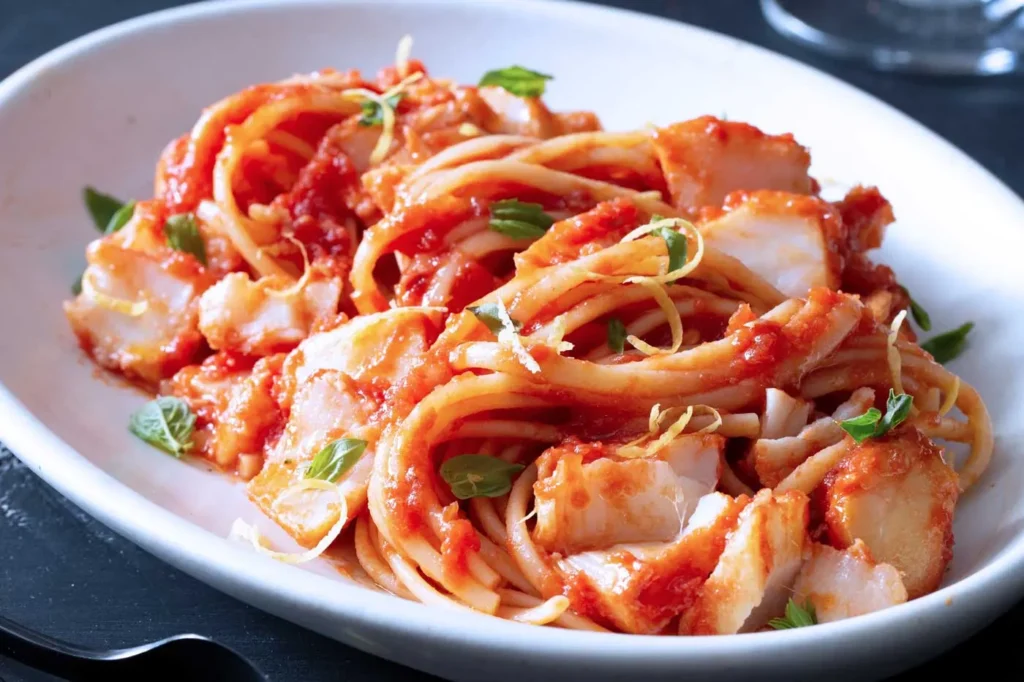
28) Baccala
Baccala, or salt cod, is a beloved dish in Italian cuisine. It is usually made by curing cod in salt and then soaking it in water to rehydrate. This process can take one to two days, requiring multiple water changes to remove excess salt. The result is a flavorful fish that can be used in many recipes.
You can prepare Baccala in several ways. One popular method is frying the fish with a flour or egg batter. This gives the fish a crispy coating. For a different approach, try simmering it in milk with garlic. This makes the fish tender and adds a creamy flavor.
Another classic recipe is Baccala with tomato sauce. You cook the Baccala in a rich, savory tomato sauce. Some versions add potatoes to the dish, enhancing its heartiness. Grilled Baccala served with roasted peppers is also a tasty option.
In some regions, Baccala is made into a spread. After boiling the fish, you mash it with some of the cooking liquid and olive oil. This creates a smooth, flavorful paste that you can enjoy on bread. Regardless of the method you choose, Baccala is a versatile and flavorful option for any meal.
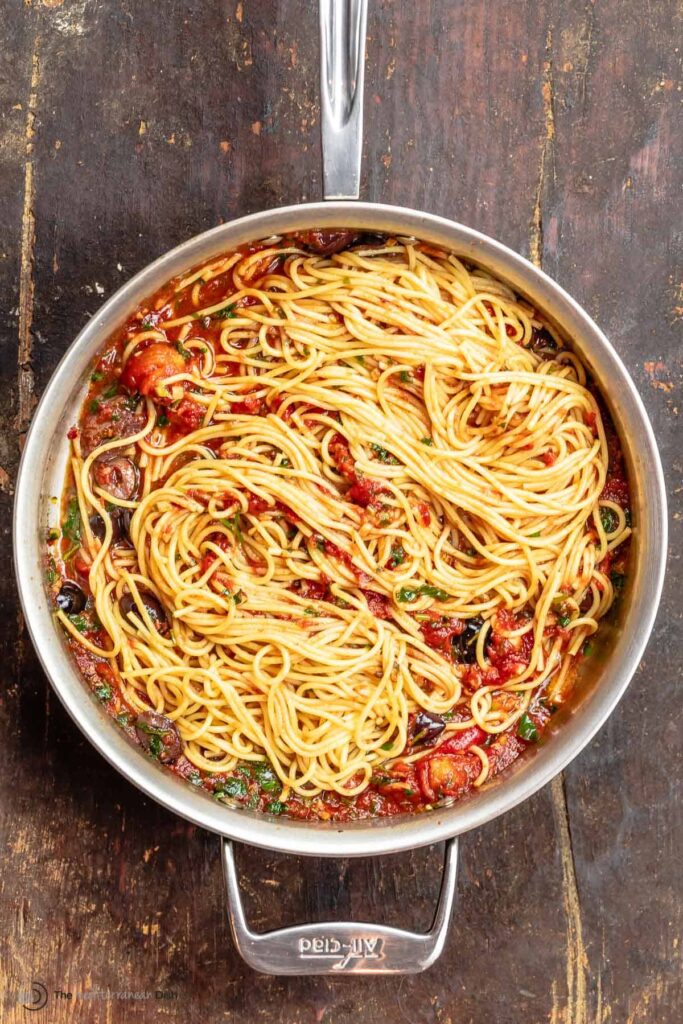
29) Pasta Puttanesca
Pasta Puttanesca is a bold and flavorful Italian dish. It’s known for its rich, savory sauce that combines tomatoes, olives, capers, anchovies, garlic, and red pepper flakes.
To start, heat olive oil in a large skillet over medium heat. Add chopped garlic, anchovy paste, and chili flakes. Sauté for a couple of minutes until fragrant.
Next, add crushed tomatoes to the pan, along with a pinch of salt and black pepper. Let the mixture cook for about 8-10 minutes, stirring occasionally. This allows the flavors to meld together.
While the sauce is simmering, cook your pasta in boiling salted water until al dente. Spaghetti works well for this dish, but you can use any pasta you prefer.
Once the pasta is cooked, reserve a cup of pasta water before draining. Add the pasta to the sauce, tossing to combine. Use the reserved pasta water to adjust the consistency if needed.
Finish by stirring in whole or chopped olives and capers. Let everything heat through for a minute or two. Optionally, garnish with fresh parsley or grated cheese before serving.
With these steps, you’ll have a delicious Pasta Puttanesca ready to enjoy.

30) Zabaglione
Zabaglione is a delightful Italian dessert that combines eggs, sugar, and Marsala wine.
To make it, you begin by whisking egg yolks and sugar together until the mixture is pale and thick.
Next, place this mixture over a pot of simmering water. Be careful that the bowl doesn’t touch the water.
Slowly add Marsala wine while continuously whisking.
The mixture will double in size and develop a custard-like consistency in about 5-10 minutes.
You know it’s ready when it forms a thick ribbon as you lift the whisk.
Serve Zabaglione warm or cold, often with fresh berries.
The smooth, rich texture pairs perfectly with the tartness of the fruit.
This dessert is simple but elegant, showcasing the best of Italian cuisine with its rich flavors and straightforward preparation.
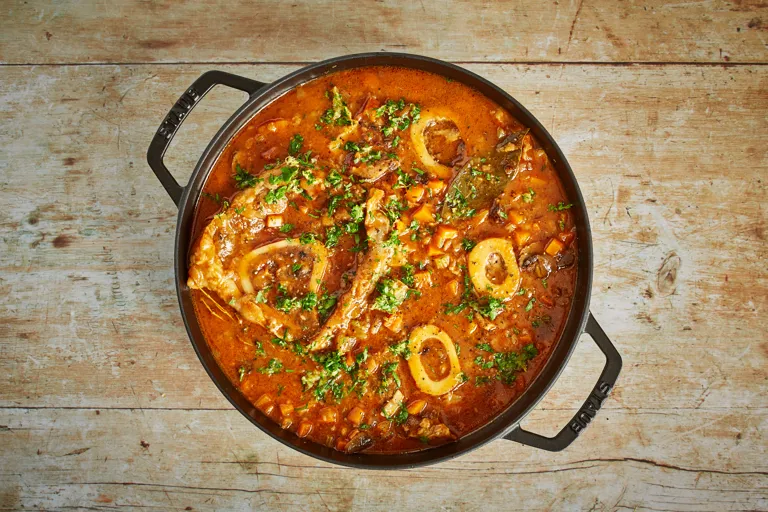
31) Ossobuco alla Milanese
Ossobuco alla Milanese is a traditional Italian dish from Milan. It features braised veal shanks cooked with vegetables, white wine, and broth.
Start by seasoning the veal shanks with salt and pepper. Dust them with flour before browning them in hot oil in a heavy saucepan. Remove the browned meat and set it aside.
In the same pan, add onions, celery, and carrots. Cook until they soften. Add minced garlic and sauté for another minute. Pour in white wine and cook until it evaporates a bit.
Return the veal shanks to the pan. Add beef broth and a bit of tomato paste. Lower the heat, cover the pan, and let it cook slowly for about 1½ hours. Turn the meat occasionally.
Traditionally, Ossobuco alla Milanese is served with a side of Risotto alla Milanese. The creamy risotto, flavored with saffron, complements the rich and tender veal.
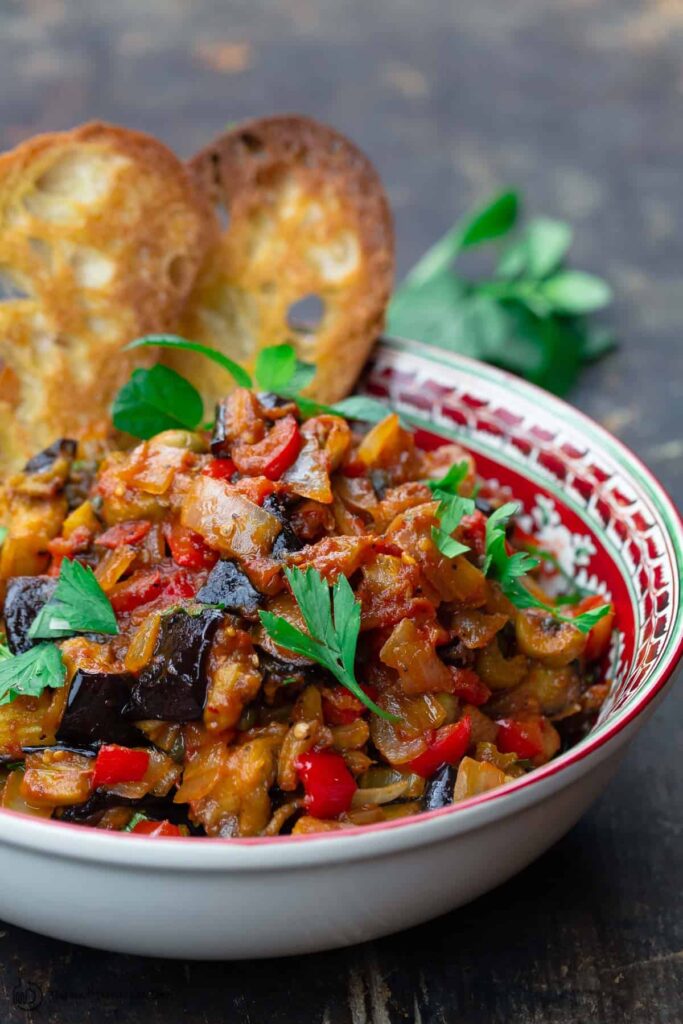
32) Caponata
Caponata is a traditional Sicilian dish. It features eggplant, tomatoes, and a mix of vegetables. You cook it down to create a flavorful, tangy relish.
To start, cut eggplants into cubes. Salt them and let them drain for about 30-40 minutes. This removes excess moisture and bitterness.
Next, thinly slice onions and sauté them in olive oil. Add diced bell peppers and celery. Cook until they soften.
Blanch, peel, and deseed fresh tomatoes. Cut them into small pieces. Add these to the pan with the cooked vegetables. Season with salt and pepper.
Stir in some red wine vinegar and a touch of sugar. Let it simmer until the vinegar scent evaporates. This helps balance the flavors.
Finally, mix in the drained eggplants and let everything cook together. Turn off the heat and let the caponata cool down. This dish can be served at room temperature or chilled.
Caponata is often enjoyed as an appetizer, side dish, or even as a topping for bruschetta. Its rich, complex flavors bring a taste of Sicily to your table.
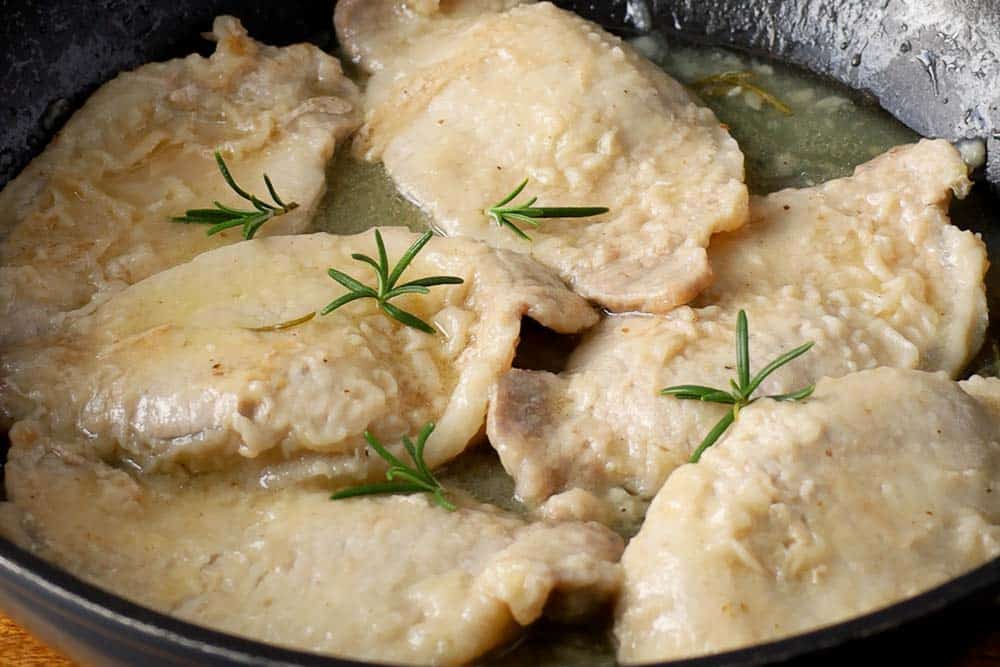
33) Scaloppine al Vino Bianco
Scaloppine al Vino Bianco is an authentic Italian dish. It features thin slices of meat, usually veal or chicken, cooked in a white wine sauce. The name “Scaloppine” refers to the thin cuts of meat.
Start by pounding the meat with a meat tenderizer. This helps to make it very thin. Then, coat the meat in seasoned flour.
In a frying pan, melt butter over medium-high heat. When the butter starts to foam, add the meat slices. Cook them for about 1 minute on each side until they are golden brown. Remove the meat from the pan and keep it warm.
Next, pour white wine into the pan. Let it bubble until it reduces by half. This should only take a few minutes. Whisk in cold butter to create a smooth sauce.
Return the meat to the pan and coat it with the sauce. You can also add some chopped parsley for extra flavor.
Serve hot with a side of vegetables or pasta. Enjoy this classic Italian dish with a glass of white wine.
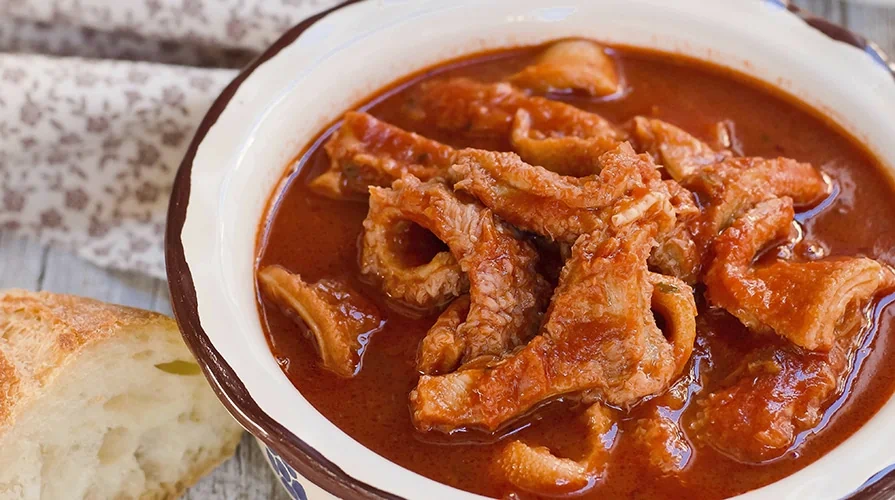
34) Trippa alla Romana
Trippa alla Romana is a classic Roman dish featuring tripe, which is the edible lining of a cow’s stomach. This traditional recipe transforms an inexpensive ingredient into a flavorful and hearty meal.
Begin by rinsing the tripe under hot water and then cutting it into strips. Heat olive oil in a large pan and sauté chopped carrots, onions, and celery.
Once the vegetables are soft, add the tripe strips to the pan. Season with salt and pepper. Cook over medium heat until the tripe begins to brown.
Next, add a splash of white wine and let it reduce. Pour in crushed tomatoes and water. Bring everything to a boil, then reduce to a simmer.
Fresh mint is often added to enhance the flavors. Cover the pan and let the tripe cook for about 30-40 minutes until tender.
Just before serving, sprinkle some grated pecorino cheese on top. Serve hot with crusty bread to soak up the delicious sauce. This dish is perfect for those who appreciate traditional, rustic Italian flavors.
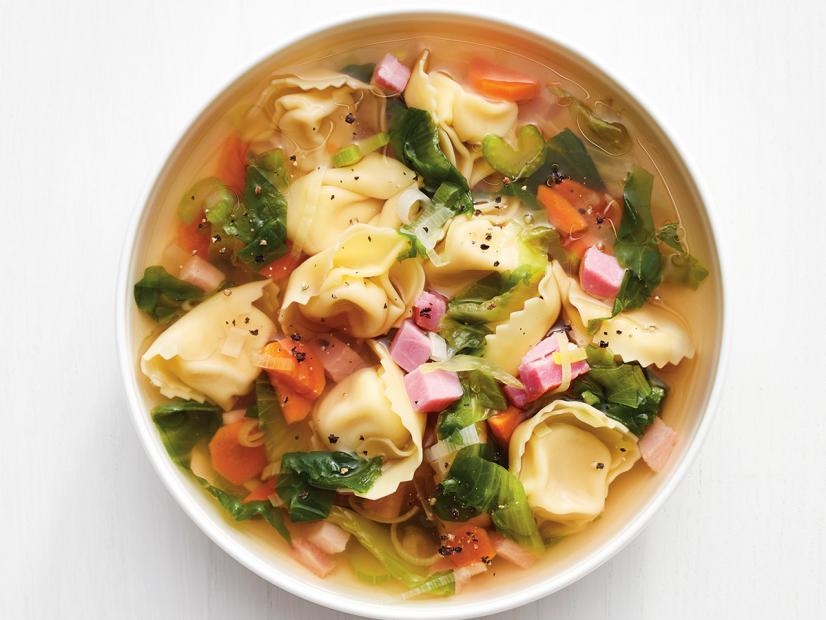
35) Tortellini in Brodo
Tortellini in Brodo is a comforting and delicious Italian dish. It’s a classic that’s loved by many.
To make this recipe, you need tortellini, usually filled with a mix of meats or cheese, and a rich broth. The broth is essential and typically made from beef bones, chicken, vegetables, and spices.
Start by preparing the broth. Combine beef bones, chicken, carrots, celery, and onions in a large pot. Fill it with water and bring to a gentle boil. Simmer for at least two hours, removing any foam that forms.
Once your broth is ready, strain it to remove the bones and vegetables. Pour it back into the pot and bring it to a boil. Add the tortellini and cook until they are tender, which usually takes around 5-7 minutes.
The result is a flavorful soup with the rich taste of homemade broth and the satisfying texture of tortellini. You can adjust the amount of broth based on how soupy you like it. Some prefer a more brothy consistency, while others like it thicker with more tortellini.
Serve hot, and enjoy this comforting Italian classic.
The Heritage of Italian Cuisine
Italian cuisine is known for its rich variety and deep ties to the country’s history and culture. This section explores how regional differences and historical events have shaped the dishes you enjoy today.
Regional Variations
Each region in Italy has its own distinct culinary traditions. Northern Italy favors butter and cream sauces, with famous dishes like Risotto and Polenta. The use of rice in the north sets it apart from other regions.
Central Italy, including Tuscany and Umbria, is known for hearty and rustic dishes. Here, you find a lot of olive oil, beans, and herbs used in cooking. Pappardelle pasta with wild boar sauce is a typical example.
In Southern Italy, the cuisine gets more vibrant with the extensive use of tomatoes, olive oil, and fresh vegetables. Pizza, originally from Naples, and pasta dishes like Spaghetti al Pomodoro are iconic here. Sicily adds a unique twist with its sweet-and-sour flavors, seen in dishes like eggplant caponata.
Historical Influences
Over the centuries, various cultures have influenced Italian cuisine. Ancient Roman cuisine laid the groundwork with its emphasis on olive oil, fish sauce, and bread. During the Renaissance, culinary practices advanced due to improved trade routes and cultural exchanges.
The Arab influence in Sicily introduced ingredients like citrus fruits, rice, and sugar. You see this in sweet desserts like cannoli and layered pasta dishes such as timballo.
Spanish rule particularly impacted southern Italy, bringing in ingredients like bell peppers and tomatoes, which became staples in Italian cooking.
Knowing these historical influences helps you appreciate the diverse and rich flavors that define Italian cuisine today.
Key Ingredients in Italian Recipes
Italian cooking relies on fresh, flavorful ingredients that work together to create delicious dishes. From aromatic herbs to rich cheeses, each component brings something special to the table.
Essential Herbs and Spices
Basil is a staple in Italian kitchens. Often used fresh, it adds a sweet, earthy flavor to sauces, salads, and pesto. Oregano is another key herb, typically used dried. It’s commonly found in tomato-based sauces and on pizzas. Parsley, especially the flat-leaf variety, is essential for adding a fresh, bright taste to many dishes, from pastas to meats.
Rosemary and thyme are often used in meats and stews, lending a piney, slightly peppery flavor. Bay leaves are usually added to slow-cooked dishes, infusing a subtle bitterness that enhances the depth of a dish. In terms of spices, black pepper and red pepper flakes are frequently used to provide a touch of heat.
Commonly Used Vegetables
Tomatoes are at the heart of many Italian recipes, whether fresh, canned, or turned into a rich sauce. Garlic is indispensable, adding a pungent, savory flavor to just about everything. Onions also play a crucial role, offering sweetness and depth to sauces, soups, and stews.
Other common vegetables include bell peppers, which add color and sweetness, and eggplants, which are often used in dishes like parmigiana. Spinach frequently appears in dishes like pasta and risotto, offering a mild, slightly sweet taste. Artichokes and zucchinis are also popular, used in both appetizers and main courses for their unique textures and flavors.
Types of Cheese
Cheese is a cornerstone of Italian cuisine, lending creaminess and richness to many dishes. Parmesan (Parmigiano-Reggiano) is often grated over pasta and risotto for its nutty, salty taste. Mozzarella, especially the fresh variety, is essential for pizza and caprese salad.
Ricotta is creamy and mildly sweet, frequently used in desserts like cannoli and in savory dishes like lasagna. Gorgonzola offers a bold, tangy flavor, perfect for salads or melted into sauces. Pecorino Romano, a hard, salty cheese made from sheep’s milk, is another favorite for grating over dishes or incorporating into sauces.
In summary, these key ingredients are essential to mastering Italian recipes, providing the foundation for the rich and varied flavors that make the cuisine so beloved.
Cooking Techniques for Italian Dishes
Italian cooking involves mastering certain techniques that bring out the best in each dish. Learning how to prepare pasta properly and utilizing slow cooking methods can be essential for achieving authentic flavors.
Pasta Preparation
Pasta is a cornerstone of Italian cuisine. Cooking pasta al dente is crucial. This means cooking it so it’s firm to the bite. Start with a large pot of boiling, salted water. Adding salt enhances the pasta’s flavor. Use about 4-6 quarts of water per pound of pasta for even cooking and to prevent sticking.
Stir the pasta occasionally to keep it from clumping together. Check the pasta a minute or two before the package instructions indicate to ensure it’s not overcooked. Once done, drain it but reserve some pasta water. This starchy water is excellent for adjusting the consistency of your sauce.
When combining pasta with sauce, add the pasta to the sauce in the pan and toss to coat thoroughly. This ensures that every piece of pasta is evenly covered with the sauce.
Slow Cooking Methods
Slow cooking is key to many traditional Italian dishes, like bolognese or osso buco. Braising is a popular technique where meat is slowly cooked in liquid. This makes tough cuts tender and flavorful. Start by searing the meat on all sides to develop a rich crust. Then, add vegetables like onions, carrots, and celery, and cook until softened.
Add liquid, which can be broth, wine, or tomatoes, and bring it to a simmer. Cover and cook the dish low and slow either on the stovetop or in the oven. This allows the flavors to meld over time and results in a rich, hearty dish.
For sauces, like ragu, simmering on low heat for hours helps develop complex flavors. Stir occasionally to prevent sticking and to check the consistency. By taking your time, you’ll achieve deep, robust flavors.
Pairing Italian Dishes With Wine
Pairing Italian dishes with wine enhances the flavors of both. The right match can take your meal to new heights.
Red Wine Pairings
Red wines are perfect for hearty Italian dishes. Chianti is a great choice for tomato-based pasta dishes like spaghetti Bolognese. The bright acidity of Chianti complements the rich, tangy tomato sauce. Amarone della Valpolicella, with its deep flavors, pairs excellently with robust meat dishes like osso buco.
For pizza with lots of cheese and cured meats, Sangiovese and Barbera can cut through the fat with their good acidity. Barolo from Piedmont is ideal for truffle dishes or rich risottos due to its strong flavor and aroma.
White Wine Pairings
White wines shine with lighter dishes. Pinot Grigio is an excellent choice for seafood pasta or light salads. It’s crisp and refreshing, making it ideal for dishes with delicate flavors. Vermentino pairs well with grilled fish or seafood risotto, enhancing the fresh and savory sea notes.
Soave from the Veneto region is perfect with creamy pasta dishes like Alfredo, complementing the creaminess without overpowering it. Gavi di Gavi, a wine from Piedmont, goes well with light appetizers like carpaccio or fresh mozzarella, bringing out their subtle flavors.
